This blog post has remained unchanged since it was written in 2024. It has largely been superceeded by my #CrossChannelRail Project Final Report
TL;DR – whatever you read in the press about future long distance train services through the Channel Tunnel is at best only part of the truth, because the reality is complicated
Periodically stories appear in newspapers, on radio and television, and also in the dedicated railway trade press, about future passenger train services through the Channel Tunnel – either new destinations to be offered by Eurostar, or completely alternative operators proposing new services. Most of these stories are based on statements made by players in the railway industry that have a particular incentive to explain the situation from their point of view, leading to inaccuracies in these reports.
This blog post is designed as a general response to those stories – a kind of overall assessment of the future of Channel Tunnel long distance passenger railway traffic, to help someone make sense of the stories that might appear in future.
If new facts emerge, or if there are errors in the text below, they will be corrected and the post updated – with changes explained and listed at the end.
Contents
- What is and is not included in this analysis
- Rationale for new services and new destinations through the Channel Tunnel
- Current situation
- Tunnel, track and station/terminal capacity
- Tunnel capacity
- Track Capacity – UK
- Track Capacity – France
- Track Capacity – Belgium
- Track Capacity – Elsewhere
- Station/terminal Capacity – Passport Control and Luggage Scan considerations
- Station/terminal Capacity – UK
- Station/terminal Capacity – France
- Station/terminal Capacity – Belgium
- Station/terminal Capacity – Netherlands
- Station/terminal Capacity – Germany
- Station/terminal Capacity – Switzerland
- Station/terminal Capacity – elsewhere
- Rolling Stock
- Operators
- Conclusions
- Updates
- Credits
- Creative Commons Images used in this post
What is and is not included in this analysis
This post only concerns long distance passenger rail transport through the Channel Tunnel – passenger trains with seats in them, typically what Eurostar has offered in the past. It does not cover vehicle shuttles through the tunnel (known as LeShuttle), or through freight services.
The focus of the piece is on operations: routes, stations, rolling stock, operators. I am not privy to enough financial information to make an assessment of the economic viability of the options here that are appear operationally possible.
Rationale for new services and new destinations through the Channel Tunnel
The idea to serve destinations other than London, Paris and Bruxelles (and stations between them) has a long history that dates at least as far back as the aborted Nightstar project, and periodically Eurostar has put forward new daytime destinations – although it has succeeded only in serving Amsterdam via Rotterdam on a permanent basis, and some other destinations in the past with temporary, irregular or seasonal services.
Even on Eurostar’s core routes, service levels today are lower than they were a decade ago (part caused by bureaucracy post-Brexit, and COVID denting Eurostar’s finances), and through passenger services have never achieved the passenger numbers hoped before the opening of the Channel Tunnel. At least until the end of 2024 Eurostar has no plans to expand its offer to/from London.
Potential new operators look at this situation and see opportunities. London and Paris are the two largest urban centres in Western Europe, and – apart from the Channel Tunnel itself – there is high speed infrastructure the whole way between the two. Examples where rivals to state incumbents have started rail services and made a success of it elsewhere in Europe (Italo in Italy, Trenitalia rivalling SNCF in France, liberalisation of high speed rail in Spain) give an idea of what could be possible to London, rivalling Eurostar that some see as over-priced and complacent. Passenger demand for rail services, post-pandemic, is strong, and the environmental rationale for modal shift to rail is clear.
So the rationale for the expansion of services is clear enough. The question is whether it is possible, and that is what this blog post will seek to assess.
Current situation
Long distance passenger trains through the Channel Tunnel are currently operated only by Eurostar International Limited, a wholly owned subsidiary of Eurostar Group.
These trains use the Channel Tunnel, and high speed railway infrastructure either side of the tunnel – High Speed 1 between London St Pancras and the tunnel, UK side, and predominantly high speed infrastructure in France, Belgium and Netherlands to reach current destinations – Amsterdam, Bruxelles and Paris. Previously Eurostar also intermittently ran services to Disneyland Paris, Lyon, Marseille and Bourg Saint Maurice, although these services are currently not operating. Eurostar currently operates around 26 services each way through the Channel Tunnel each day at summertime peaks, down from around 30 trains each way a decade ago.
Eurostar Group is owned 55.8% by SNCF (French state owned railway company), 19.3% by Caisse de dépôt et placement du Québec (Canadian institutional investor), 18.5% by SNCB (Belgian state owned railway company), and 6.4% by Federated Hermes (American investment manager).
Available routes
Long distance passenger services through the Channel Tunnel are comprised of three sections of route: the part above ground in the UK, the Channel Tunnel itself, and then parts above ground in France, Belgium, Netherlands and any subsequent countries. Any assessment of future services needs to start here: where would new services run? Would there be more trains on existing routes, or trains on new routes?
Available routes – UK
There is essentially only one available route – High Speed 1 from the St Pancras Station in London to the Channel Tunnel, via Stratford International, Ebbsfleet International and Ashford International.

Re-using the old Eurostar terminal at Waterloo can be eliminated as an option – these platforms are now used by regular UK rail services, and to reach Waterloo you need a train that can run on 750v third rail dc electrification, and has the restricted UK loading gauge (see Rolling Stock below). Waterloo is out.
Through routes to anywhere else in the UK are only fractionally easier – there is a connection from High Speed 1 to the North London Line (see OpenRailwayMap here) that then could be used to connect to the West Coast Main Line, but while this all has overhead electrification at 25kV 50Hz ac, loading gauge problems (and as a result limits on rolling stock), and Passport Control issues (see below) still apply. Connection to the Lea Valley Lines at Stratford (see OpenRailwayMap here) is no good, as the connecting curve is the wrong way, while leaving High Speed 1 at Barking (see OpenRailwayMap here) leaves you with a contorted route through north London. High Speed 2 will also not connect to High Speed 1. So long distance routes serving any stations in UK other than those along High Speed 1 can be eliminated as well.
The only choice for the future is hence which stations to serve along High Speed 1, and whether to use the entirety of the line, or only part of it.
Signalling systems required for the UK part of the route are hence clear – the requirements are the same as in France, with both KVB and TVM430 required.
How St Pancras works is well known – all of Eurostar’s services to the UK terminate there, but there are problems with terminal capacity (see below).
Stratford International – despite the name – has never been served by international trains, and there are no passport control or bag scanning facilities there currently (although installing these would not be complicated).
The track and platform layout at Stratford is also problematic. The station has 4 platforms. There are two long platforms on the outsides (Platforms 1 and 4) currently not in use but foreseen for Channel Tunnel services and hence long enough to accommodate 400m trains. The island platform in the middle (Platforms 2 and 3) is much shorter – about 250m. However only Platforms 2 and 3 have points to the eastern end of the station that allow a train to arrive from the east (the south track) and depart towards the east (north track). Such a switch between Platform 1 and Platform 4 is not possible, nor is there place to build it east of Stratford as the tunnels are single bore.
This means that trains departing from St Pancras could additionally call at Stratford, but Channel Tunnel services could not start or end at Stratford as there is no means to reverse trains there.
Temple Mills depot – with a connecting curve above Stratford International station (see OpenRailwayMap here) – would be used for stabling trains that start and end in London, as is currently done by Eurostar.
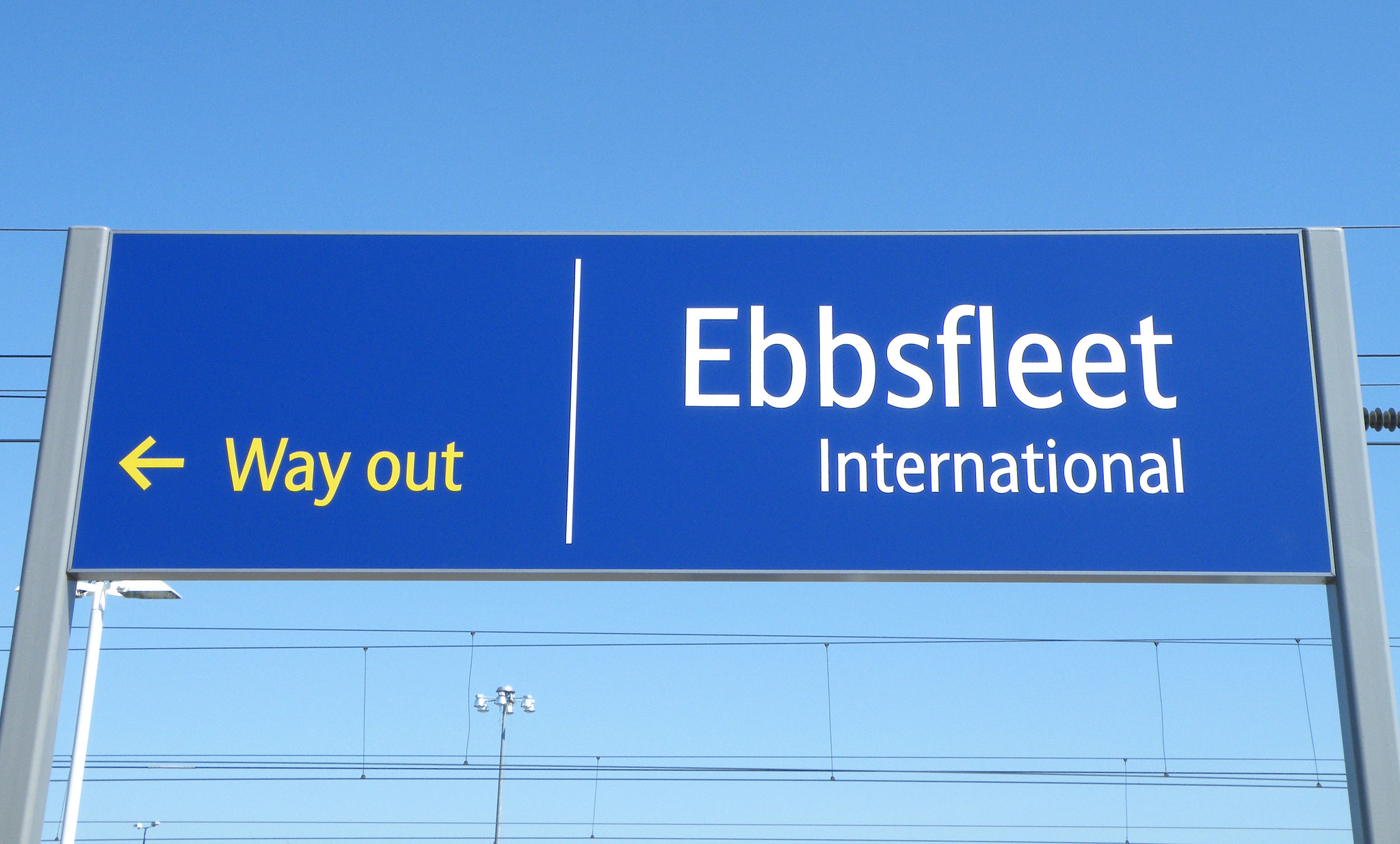
Trains could possibly begin and terminate at Ebbsfleet International, because there the track layout would allow a change of direction, although there is just one single platform where this would be possible (you can work it out from OpenRailwayMap here). However at Ebbsfleet there is nowhere to stable trains.
Ashford International is somewhat easier – terminating trains at either of the two international platforms would be possible (see track layout on OpenRailwayMap here). Problems with loading gauge and electromagnetic interference for Eurostar’s Siemens e320 trains have been overcome at Ashford as well, so no problem with that. However the depot at Ashford has only 750v dc electrification, so cannot be used by any Channel Tunnel compatible trains, even the older Eurostar e300 (see Rolling Stock below) that has had its 750v dc equipment removed. The nearest stabling point would be Dollands Moor (see OpenRailwayMap here), close to the Channel Tunnel.
This then leaves us with only two options for routes, UK side – either run from St Pancras to the Channel Tunnel (with or without interim stops at Stratford International, Ebbsfleet International and Ashford International), or begin/terminate services at Ebbsfleet or Ashford, but doing so would require fast turnarounds due to limited platform capacity, and for trains to be stabled somewhere a long way from either.
Available routes – France, Belgium and beyond
The choice of routes beyond the French portal of the tunnel is much more varied than UK side. Indeed from the junction just north of Calais-Fréthun station (see OpenRailwayMap here) it is possible to access either the French classic railway network (25kV 50Hz ac electrification, speeds 160-200km/h) towards either Calais/Dunkerque or Boulogne, or the high speed network (25kV 50Hz ac electrification, 300km/h) towards Lille. Loading gauge is likewise not a problem on any of these lines.

The most obvious routes take the LGV Nord high speed line to Lille first (through Lille Europe station) and then take either the branch towards Bruxelles and onto HSL 1, or the rest of LGV Nord towards Paris.
KVB signalling system is needed for the French classic network in all cases (it is needed to access Paris Nord after exiting LGV Nord). TVM430 signalling is required for LGV Nord. Both of those are required for High Speed 1 in the UK as well. Electrification as far as Paris is also all 25kV 50Hz ac. So KVB, TVM430 and 25kV 50Hz ac are, for now, the minimum requirements.
The further you go into France, so technical requirements get more complicated. Beyond Paris, the older TVM300 signalling system is required to run towards Lyon (LGV Sud Est) or Tours (LGV Atlantique), and while those lines are 25kV 50Hz ac, the stations off the lines (such as Lyon Part Dieu or Bordeaux St Jean) are wired at 1.5kV dc.
Eventually TVM will be replaced with ETCS – likely from 2025 on LGV Sud Est and LGV Atlantique, but only around 2030 on LGV Nord (and indeed through the Channel Tunnel and on High Speed 1 – implementation on all three is supposed to be coordinated). All of this has implications for the choice of rolling stock for future services (see below) – both in terms of the requirements for new stock, and whether existing stock might no longer be appropriate on lines that are subsequently upgraded.
Running beyond France adds additional technical complexity.
Bruxelles Midi, like the rest of the Belgian classic network, is wired at 3kV dc, and currently the Belgian TBL safety system is required to run there. By the end of 2025 this should no longer be required, and ETCS will be able to be used instead (more about this from Infrabel here) – and indeed from 2026 all trains running in Belgium must be equipped with ETCS – this also has rolling stock implications (see below).
Running to Netherlands requires 1.5kV dc, ETCS signalling to use the high speed line HSL Zuid, and ATB for the classic network (eventually to be replaced by ETCS, but work is not proceeding as swiftly as in Belgium).
Running to Germany or Switzerland additionally requires 15kV 16.7Hz ac, and for Germany PZB and LZB safety systems. All of Switzerland, and Barcelona Sants, can be reached with ETCS only, but going further into Spain requires ASFA. 25kv 50Hz ac is sufficient for standard gauge lines in Spain. Italy requires 3kV dc, and BACC. Going even further beyond any of these will add even more technical complexity.
Overall, running in northern France is simplest. Routes further into France, or into Belgium and beyond, present some significant but not insurmountable hurdles, some of which may be eventually reduced once ETCS is prevalent. But the constraints as to where to run are not imposed by the network or the technical complexity in France, Belgium or beyond.
Tunnel, track and station/terminal capacity
Once you have worked out where it might make sense to run, the next question is: does capacity exist to run there?
Tunnel capacity
The Channel Tunnel was designed for standard running with 10 trains per hour (6 minute headways) per direction (see this 1989 paper about its design), with the opportunity to accommodate 15 trains per hour (4 minute headways) at peak.

Theoretically there can be up to 7 truck shuttles an hour, 4 car shuttles an hour, and 3 Eurostar trains an hour through the tunnel – so 14 trains per hour, leaving 1 slot spare, and assuming through freight services – that have never reached the projection – can be run at off-peak hours. How often the Channel Tunnel ever runs at this level – 14 trains per hour – was impossible to determine for this piece, as a full timetable of when truck shuttles run at 7 trains per hour is not available.
Eurostar’s services have also dropped slightly in recent years. In 2024 the busiest day of Eurostar services I could find – a peak summer Friday – had 16 trains from Paris to London, and 10 from Bruxelles to London. This compares with 19 from Paris and 11 from Bruxelles in the summer of 2013 (see historic Eurostar timetables here – .rar files need to be decompressed).
With regard to tunnel capacity, it suffices here to say that there is definitely capacity for more long distance passenger trains off-peak, and probably at least 1 slot per hour available even at the highest summer peak times.
Track Capacity – UK
Up to 3 Eurostar trains per hour per direction, plus 4 Southeastern high speed trains per hour. The differences in speed (Eurostar – 300km/h, Southeastern – 225km/h) and stopping patterns (Southeastern stops at Stratford International, Ebbsfleet International, Ashford International and not all Eurostar trains ever did and none currently do) mean it will not be possible to use capacity as effectively here as through the Channel Tunnel where all trains have the same speed and stops, but there is capacity on High Speed 1 for at least another 2 trains per hour. No problem here.
Track Capacity – France
The section of LGV Nord between Calais and Lille is one of the least used high speed lines in France, so no issue, and indeed no problem the whole way as far as where the spur from Arras joins LGV Nord (see OpenStreetMap here). Even the section between Arras and Paris Gare du Nord (the most used part of LGV Nord) should present no problems – this normally has 6 or 7 high speed trains an hour on it, meaning capacity for at least 2 more trains per hour. LGV Est (to Strasbourg) has plenty of capacity, but LGV Sud Est (to Lyon) does not – until ETCS is installed (supposedly 2025), but given the rolling stock questions (see below), running to Lyon before 2025 is unlikely anyway – so basically there is capacity on French high speed lines wherever anyone might ever want it. Same for French classic lines that have been under-used for decades. Routing through France to get to Basel (Switzerland) might run into path conflicts between Strasbourg and Basel or, until 2025, if LGV Sud Est and a route via Dijon were used instead – but here too nothing is insurmountable according to the timeframes imposed by other aspects of the operations.
Track Capacity – Belgium
Where the high speed line meets the regular rail network at Hal and runs as Line 96N to Bruxelles, there is the possibility for some path conflicts, but given there are 2 tracks for stopping trains and 2 tracks for high speed trains, these can likely be resolved. So running to Bruxelles Midi should be no problem. Beyond Bruxelles Midi is more problematic – not least because the Midi-Nord tunnel is at capacity at peak times, but running off peak would work. Even at peak reversing at Midi and running via Gare de l’Ouest would be an option. The complex and slow infrastructure towards Antwerpen (necessary to run to Netherlands) is likewise a potential bottleneck, but overall 1 more train per hour at peak, at least 2 off peak, through Bruxelles and northwards towards Antwerpen and Netherlands, and eastwards towards Germany, should be possible.
Track Capacity – Elsewhere
HSL Zuid in Netherlands has extra capacity, and runs as far as the edge of Amsterdam, so would not present major headaches. Köln is a bottleneck in Germany, but more in terms of the station (see below) than in terms of track capacity. Were trains to ever reach Switzerland, paths between Basel and Zürich at peak times could be a problem, off peak would however work. Generally, track capacity is not going to prove to be the show stopper for any of these destinations.
Station/terminal Capacity – Passport Control and Luggage Scan considerations
Long distance trains that use the Channel Tunnel are subject to two constraints that generally do not apply to other rail services. Both a passport control and a luggage scan have to be performed before a passenger boards the train, or this has to be done external to the train somewhere en route (so called “de-training” – basically ask everyone to get off the train with their bags somewhere, and then re-board again).
This poses operators a conundrum.
For new operators that might try to rival Eurostar, do they simply opt to use terminals at the stations used by Eurostar where the infrastructure for passport controls and luggage scans is in place already? This will limit the routes they could operate.
For stations beyond those currently served by Eurostar – whether these would be served by Eurostar or someone else – what is the solution? To install passport control and luggage scan infrastructure? To hope passengers will stomach an extra stop en route for de-training? Or to lobby for a change in the law to mean passport or luggage checks are performed somehow differently?

Here I am going to make some judgment calls. Due to the currently fraught state of the discussion in Britain about immigration, the UK is not going to abandon so-called juxtaposed controls – this means that passports are controlled before a passenger leaves French or Belgian territory, and that will continue to be the case. See the background of this system here.
The only question then is how and when passports could be controlled. At the moment this is done in booths in the stations (Paris Gare du Nord, Bruxelles Midi etc.), but theoretically could be done by UK Border Force staff on board moving trains before these trains reach the Channel Tunnel. However at the time of writing, UK Border Force has neither the technology nor the political will necessary to switch to checking passports on board international trains rather than in the stations. Maybe some operator in the future can persuade the UK to make this change, but for now my assumption is that passports will need to still be checked in stations in the future. This is probably the most major constraint on future long distance train operations through the Channel Tunnel.
At the moment passengers at Eurostar terminals are subjected to airport style checks – not only is every item of luggage scanned, but passengers are asked to remove watches, belts etc. – this is notably more strict than the scans to board AVE trains in Spain, where only bags are scanned. While I can find nothing in the 1994 Channel Tunnel (Security) Order (full PDF here) that makes this obligatory, I nevertheless see no will from operators (current or future) to stop doing this, although somewhat lessening the thoroughness of scans so as to speed them up could be possible. However given luggage scans can be conducted at the same time and same place as passport controls, making a change here is not the highest priority. Hence the default is that both luggage and passports will continue to be checked in stations in future.
I also see the “de-training” option – whether passengers disembark somewhere en route for passport and luggage checks – as an inadequate solution for anything except irregular leisure trips. Eurostar used to get passengers on its Lyon Part Dieu – London trains to disembark in Lille Europe for this, making the Lyon – London trip almost an hour longer than in the other direction. But even from a rail operations point of view this is inadequate, as a train is left blocking a platform for up to an hour. So “de-training” will not be considered for anything except niche leisure cases.
Station/terminal Capacity – UK
Stations in UK with the necessary infrastructure already:
– London St Pancras (in use)
– Ebbsfleet International (not currently in use, but has been used in the recent past)
– Ashford International (not currently in use, but has been used in the recent past)
Stations in UK where infrastructure could be reasonably easily added:
– Stratford International
The problem at St Pancras is not that the infrastructure exists, but whether it is adequate to process passengers fast enough. As this 2022 story explains, passenger throughput at St Pancras has dropped at St Pancras from 2200 passengers per hour to 1500 per hour, due to the additional time taken to perform passport checks, post-Brexit. Eurostar has tried to address the problem with its pilot of the biometric SmartCheck system in 2023, but that only applies to the UK passport check and not the French one, and it is the latter that is the bottleneck. Furthermore with the Etias Schengen border system due to be rolled out in 2024 (exact date tbc), the time to check passports at St Pancras is likely to increase further, and so throughput will drop even more. With Eurostar’s e320 trains seating 900 passengers, and its older e300 trains 750 people, the current throughput of the terminal limits capacity to just 2 departures per hour – if trains are to leave full.
A solid and reasonable solution for this problem – a kind of UK-Schengen mutual recognition system, or an automated Schengen digital or biometric entry system – is politically impossible at present, as the UK Government would not sanction such a thing as it would call one of the core aspects of Brexit – border control – into question. A fix for this should be high on the list of priorities for a new UK government with a Labour Prime Minister in late 2024 or early 2025 in the UK, but change before then is impossible, and even then unlikely. The problem in particular is that at St Pancras the terminal is so physically constrained that there is simply no place to put the extra passport booths that would be needed to increase passenger flow.
This problem is exacerbated still further by the decision by Eurostar, post-COVID, to suspend stopping their trains at both Ebbsfleet and Ashford (and this will persist throughout 2024). As terminals in both of those stations are not as excessively overcrowded as the one at St Pancras, allowing passengers to board there – and perhaps even with a strong financial incentive to persuade passengers to do so, or some kind of combined ticket with Southeastern trains – would increase total throughput. A more radical solution would be to open Stratford International for international passengers – a good option for London as Stratford is so well connected by public transport. At the moment I see no appetite for any of these solutions from Eurostar, but it could be something rival operators could examine.
The platforms at St Pancras are not the capacity constraint – 6 full length (400m) platforms are available for international services.
Maintain the status quo – St Pancras only, and no changes to the passport regime – and there is only a tiny bit of spare capacity for additional services in the early morning or late evening hours, and possibly a train or two in the midday lulls on weekdays. Any potential operators could of course bid for capacity currently used by Eurostar, and win, but that does not increase capacity overall – just re-allocates it. The only way to make a meaningful difference to overcome this station/terminal capacity constraint, short term, is to somehow lessen the pressure on St Pancras by using Ebbsfleet and Ashford, and possibly even Stratford.
Station/terminal Capacity – France
Stations in France with the necessary infrastructure already:
– Calais-Fréthun (not currently in use, but has been used in the recent past)
– Lille Europe (in use)
– Paris Gare du Nord (in use)
– Marne-la-Vallée–Chessy (for Disneyland) (not currently in use, but has been used in the recent past, allows only departures northbound, no through traffic)
– Bourg Saint Maurice and Moûtiers-Salins-Brides-les-Bains (for ski trains) (not currently in use, but have been used in the recent past)
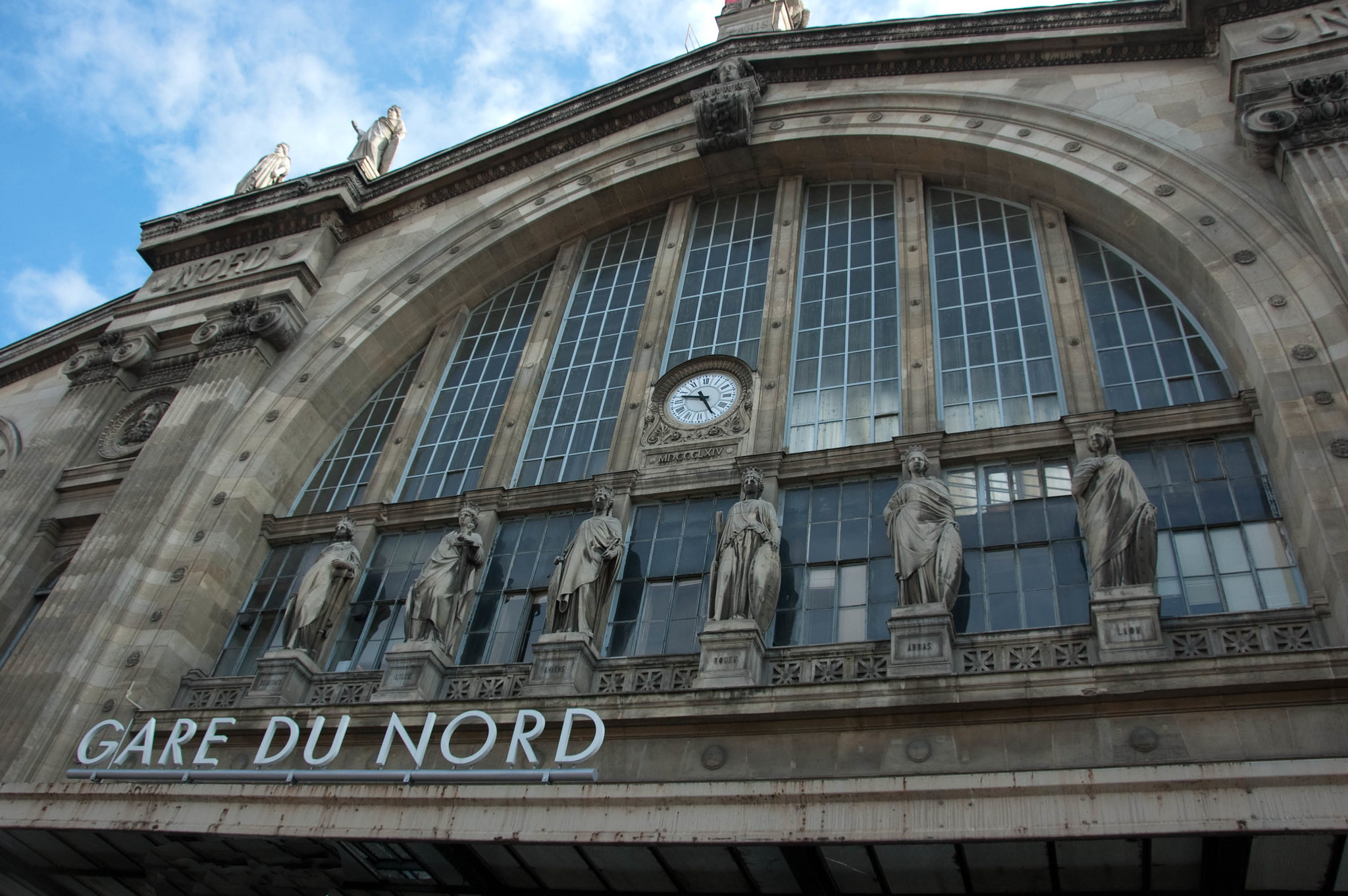
Station and terminal capacity is not such a major constraint at Paris Nord as at London St Pancras, but things can get busy for passengers at peak times. Throughput for passport checks (facilitated by passport gates for passengers exiting France) and luggage scans is not a constraint to the same extent as in the UK, and 4 secure platforms offer adequate capacity. Likewise Lille Europe and Calais-Fréthun (mothballed in the same way as Ebbsfleet and Ashford) likewise have adequate capacity – both in terms of passenger throughput and platforms.
Marne-la-Vallée–Chessy, Bourg Saint Maurice and Moûtiers-Salins-Brides-les-Bains do not especially concern us here, for their use has been for intermittent leisure trains in the past. Marne-la-Vallée–Chessy could be a destination for a kind of “OUIGO-star” low cost train serving greater Paris were Gare du Nord too expensive, but that is a financial rather than a capacity constraint.
There are more serious problems with other possible destinations in France. Details of platforms at French stations can be found here. There is no viable way to cordon off a platform for passengers post-passport check and bag scan at Lyon Part-Dieu station – the station is already bursting at the seams. Even Lyon-Perrache, less well connected, has no easy way to separate passengers by different type of train. Charles De Gaulle Airport TGV has only 2 island platforms (can be seen in this picture), and so would also not work. Likewise there is no obvious way to do it at Strasbourg where the only platforms long enough to accommodate 400m trains are mixed-use with other long distance and regional services. Even Marseille Saint Charles presents problems – the platforms to the sides at this terminus station are too short, with the 400m+ platforms placed centrally. Only Bordeaux St Jean – where Platform 1 could be used – looks viable for adaption. Dijon – while likely not significant enough to serve on its own – could possibly work as a stop for trains to/from Switzerland (see below). So while the passport check and bag scan regime is at is, forget through services to other French destinations – “de-training” in Lille, for occasional services is the best you will get.
Station/terminal Capacity – Belgium
Stations in Belgium with the necessary infrastructure already:
– Bruxelles Midi
The Eurostar terminal at Midi might be small, but there is sufficient capacity there for a moderate expansion of services, not least as platforms 3 and 4 at the station have been adapted for through trains from Amsterdam to London, in addition to terminus platforms 1 and 2. Full details of the Brussels terminal capacity are in this PDF.
The only other Belgian stations that merit consideration are Antwerpen Centraal and Liège-Guillemins. Eurostar trains transit Antwerpen en route from London to the Netherlands but do not stop, but given the station is only 35-45 minutes from Bruxelles Midi, depending on the type of service, it has never been justifiable to secure one of the underground level platforms for London services. Liège would be easier – Platform 1 there is both long enough and easy enough to secure – but that would be served by trains onwards to Germany, and the German side of the border has its own problems (see below). So terminals are only of marginal importance regarding future plans for serving Belgium.
Station/terminal Capacity – Netherlands
Stations in Netherlands with the necessary infrastructure already:
– Rotterdam Centraal
– Amsterdam Centraal (a planned closure of this terminal is temporary)
Rotterdam and Amsterdam are the obvious destinations from London, and the capacity at the Amsterdam terminal – just 250 passengers per train – has been a major constraint, and that is why after a 6 month closure the capacity there will be increased. From c. 2030 international trains will serve Amsterdam Zuid rather than Centraal, and capacity will be increased further. Capacity at Rotterdam – a modern station – is not a problem. The only other stations it might make sense to serve – Schiphol Airport and Utrecht Centraal – are both close enough to Rotterdam and Amsterdam, and capacity at both constrained enough, to mean effort to serve London from either has not been undertaken, nor is it likely.
There is one other station in Netherlands with potential – Den Haag HS (see OpenRailwayMap here). Platform 1 is currently unused, and is separate from other platforms at the station, although the platform is short of the ideal 400m length. Serving (or even terminating) trains at Den Haag would mean not using part of the HSL Zuid line, but given constraints at Amsterdam could be appealing for a new operator.
Overall though, in Netherlands terminals are only of marginal importance regarding future plans for serving the country.
Station/terminal Capacity – Germany
Stations in Germany with the necessary infrastructure already:
none
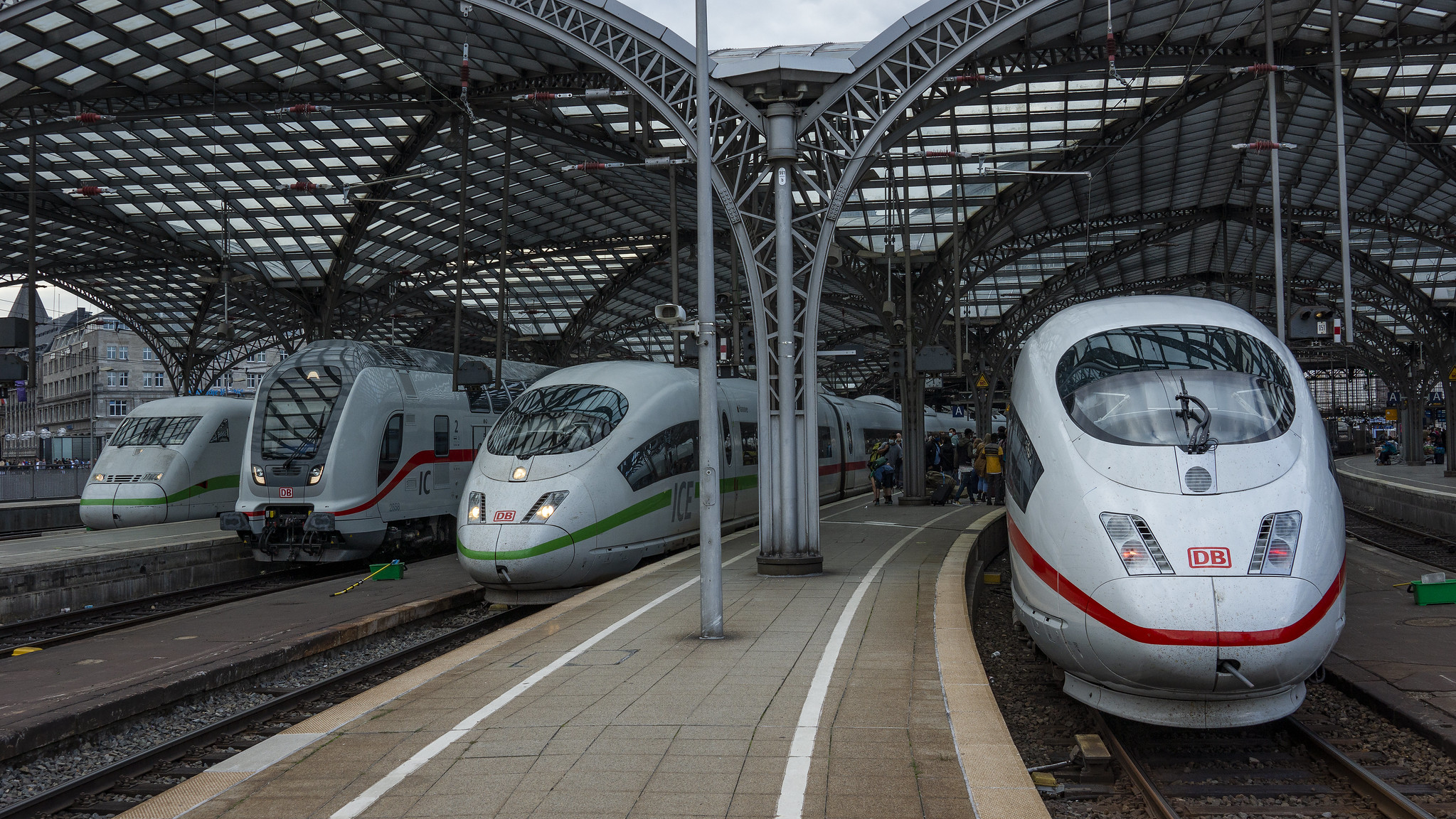
Ever since Deutsche Bahn ran a test ICE train to St Pancras in 2010 (the cover picture for this post), everyone has been awaiting through services from Germany to London. But problems with stations is one of the main reasons why this has never happened. Were a train from Germany to run through Belgium, it would be desirable to stop at Köln Hbf and Aachen Hbf, and both stations are congested and have no suitable platforms that could be cordoned off for passengers after passport controls and bag scans.
It has been suggested that Platform 1 at Köln Hbf could be cordoned off, but this platform is only easy to approach from the west. Departing from that platform towards the west would either require a new flyover at the yard west of Hansaring, or a contorted route going east first, crossing the Rhein, to then loop back across the south bridge.
Köln/Bonn Flughafen station is no alternative – an underground station with 2 island platforms, no way to cordon anything off. Köln Messe/Deutz is likely too congested as well. There would be space at Köln West or Köln Ehrenfeld to build a complete new terminal, but doing so would stretch well into the 2030s.
Düsseldorf Hbf would be easier (platforms 19 and 20 could be used), but running to Düsseldorf without a stop at Köln would be a rather peculiar outcome.
Further south Frankfurt (Main) Hbf would work at a push, where one of the platforms to either the north or likely better the south side of the hall could be used. But other stops en route to either Belgium or France – Frankfurt Flughafen, Mannheim Hbf, Saarbrücken Hbf and Karlsruhe Hbf – suffer the same problems as other German stations, namely overcrowding and difficulty separating off a platform for UK-bound services. Given some of these services would also likely call at Strasbourg – likewise problematic (see above) – the prospects here look bleak.
Stuttgart Hbf is currently being rebuilt, and the future version with through platforms would be much harder to adapt for Channel Tunnel services than the current terminus station. München Hbf, were services from London to extend that far, would however possibly work – it is a terminus station with a lot of platforms.
Whether there would be political will to even make necessary station changes in Germany is questionable. Unlike Spain, and to some extent France and Belgium, Germany has shown no wish to try to introduce airport style security to its railways, and given how congested many of its stations are, I see little will for accommodation on this point.
So – basically – other than Frankfurt and München, stations in Germany present a major problem. Only some very expensive rebuilding, or some radical change of policies regarding UK borders is going to make through trains to Germany possible.
Station/terminal Capacity – Switzerland
Stations in Switzerland with the necessary infrastructure already:
none
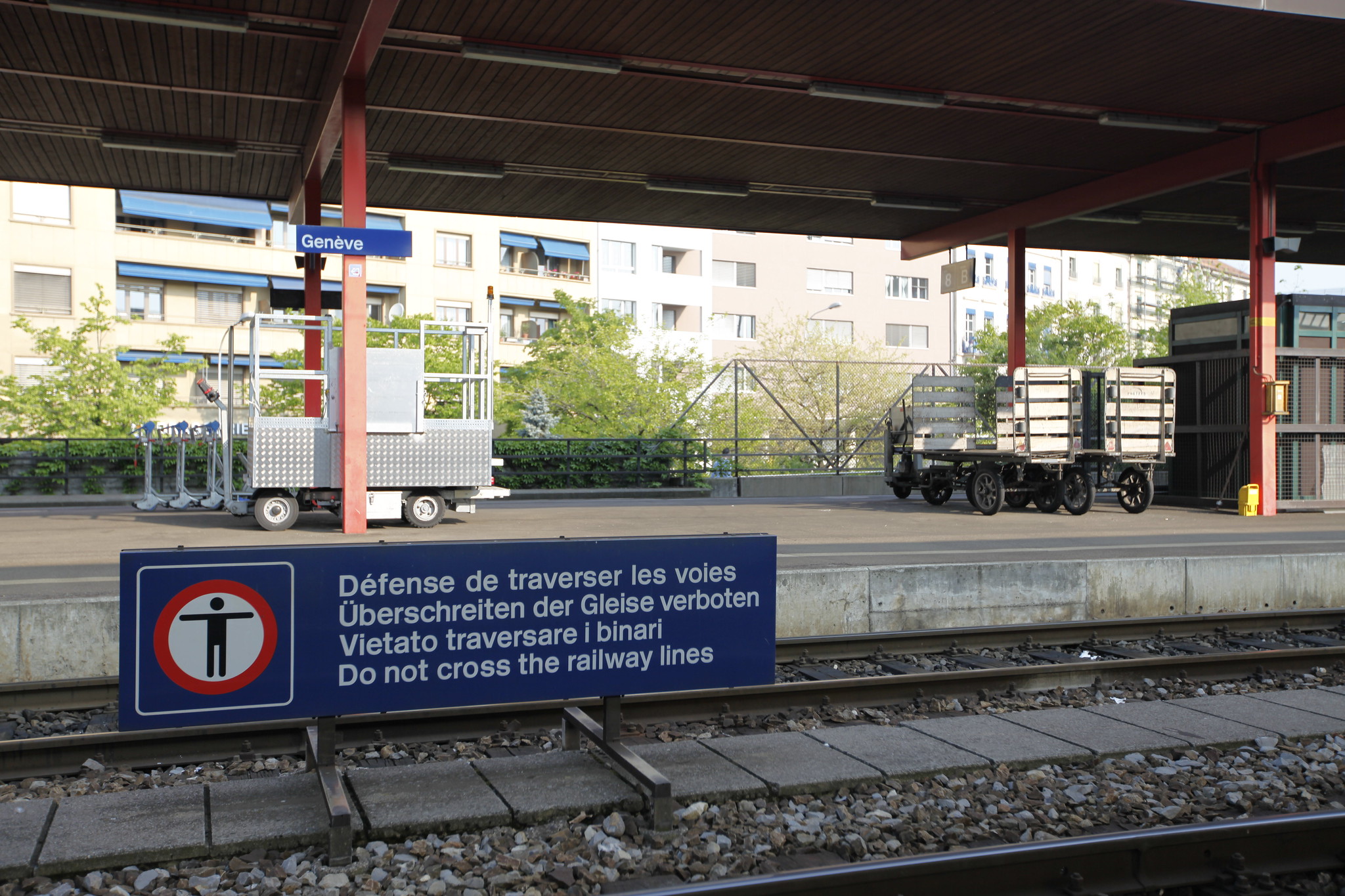
Switzerland is perhaps not as complicated to serve as it might originally look. Both Basel SBB and Genève have semi secured platforms for trains that used to arrive at each from France – where customs controls used to be performed for arriving passengers. There is 1 400m semi secure platform at Basel SBB, and 2 at Genève – details of station platforms in Switzerland are here. These platforms can also be reached with 25kV 50Hz ac electrification – only beyond Basel or Genève is 15kV 16.7Hz ac required.
However Basel SBB is about to be partially rebuilt though – I cannot easily assess how these plans will impact whether trains from London could easily be accommodated. However there are also plans to build a railway connection to EuroAirport Basel Mulhouse Freiburg, and while this airport is on French territory there is also a transit route to Switzerland – so if Basel SBB would not work, a terminal for Channel Tunnel trains that could serve Basel and Mulhouse might work there, but only sometime towards 2030.
Operating services through Basel SBB onwards to Zürich HB would render the situation in Basel SBB more complicated (one of the more congested and harder to cordon off through platforms would have to be used). Upon reaching Zürich, using either platform 3 (south side) or 18 (north side) of the terminus platforms might, at a push, be possible – although fencing these platforms off from the streets beside them would likely not be popular. However international trains in Switzerland arriving from France and Germany have traditionally had to be fitted into the Swiss “Takfahrplan” (clock face timetable) between Basel and Zürich – applying this to a service to/from the Channel Tunnel could complicate the security situation considerably.
A problem for services to Switzerland would be what stations, if any, could be served en route. Strasbourg is problematic (see above), Mulhouse too close to Basel to justify adapting, and the secure platform at Marne-la-Vallée–Chessy is a terminus platform, not a through platform. That leaves Dijon and Lille Europe as the only viable interim stops. With a journey time over 5 hours from Basel and Genève, and over 6 hours from Zürich, this would be stretching the boundaries of viable services. So stations are not really the constraint for Switzerland, but running from here to London is also far from simple.
Station/terminal Capacity – Elsewhere
The only country a viable daytime train distance from London is Luxembourg (running through France, rather than through Belgium), but here too the platform setup at the station is complicated – at least for 400m trains. 200m trains, at the terminus platforms, could possibly work.
Adapting any Spanish high speed station would not be complicated as pre-boarding bag scans are normal in those stations, but even Figueres-Vilafant, Girona or Barcelona Sants are upwards of 7 hours from London, so likely not viable. Italy or Austria are even further, so are not examined here. So other than Luxembourg, destinations anywhere else look unviable.
Rolling Stock
General considerations
A idea has long persisted that passenger trains that are allowed to transit the Channel Tunnel need to be close to 400m in length (roughly equivalent of 2 TGVs in length, or 16 regular carriages).
Whether this is indeed the case or not is not at all simple to determine.
The Channel Tunnel has emergency doors from the rail tunnels to the service tunnel at 375m intervals. This means that a door of a stranded original Eurostar e300 train would be either right next to, or very close to, an emergency door. However from the outset two other types of rolling stock – Regional Eurostar sets, and Nightstar – were planned to be used through the Channel Tunnel, and neither of these train types are 375-400m in length. A regional Eurostar is about 312m long, and a Nightstar was planned to have 8 regular carriages, so something around 200m length. Neither of these trains ever ran through the tunnel, but it is inconceivable they would have been built without knowledge that they would be approved.
Paragraph 60 of this 2010 House of Commons Report nevertheless implies that the minimum length requirement does exist, and that it had never been repealed – and the only change that had been made for the sake of Deutsche Bahn’s efforts to run trains through the Channel Tunnel is that distributed traction (i.e. motors under the floor, instead of grouped in a locomotive at the end of the train) is allowed – something that Eurostar has subsequently proven with its e320 trains. However the opinion of the EU Agency for Railways at the same time was that there was no logical reason to oppose the use of shorter trains.
However there is no reference to a length requirement in the latest (2017) Document de référence du tunnel sous la Manche pour la reconnaissance mutuelle des véhicules ferroviaires (PDF here) that stipulates the requirements for trains to operate through the tunnel. More in English, on the Internet Archive here. We also know that DB received an approval to run in the tunnel in 2013 – but that seems to apply to Deutsche Bahn as a company, and not ICE 406 trains in particular.
And as if that were not all messy enough, CEO of Getlink Jacques Gounon repeated the line that there is a length requirement in this 2022 interview – would the CEO of Getlink not know his own rules?
So the conclusion here is that we do not know what the rules are for certain, but given DB ended its efforts to run through the Channel Tunnel for reasons other than rolling stock approval, I think on balance we can conclude this is not where the problems are.
Existing rolling stock
Three types of passenger rolling stock have been used through the Channel Tunnel, of which two types are in everyday use.
Eurostar e300 / TMST
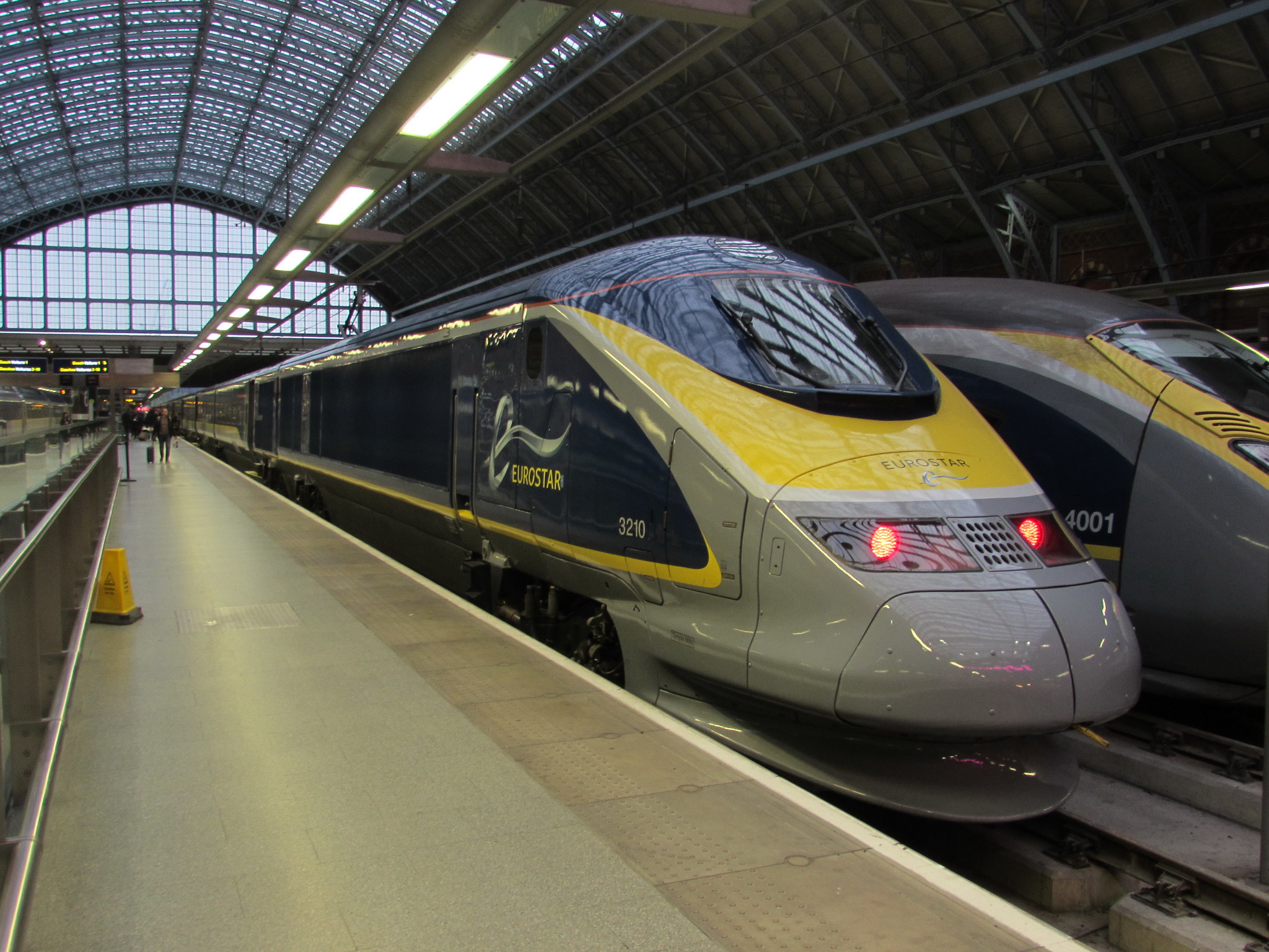
The original Eurostar trains, in service since the Channel Tunnel was opened. These trains are composed of two power cars, 18 carriages, seat 758 passengers and are 378m in length. 38 of these trains were built, 16 have been scrapped, 10 are in long term storage, 1 preserved and 11 are in operation – all for Eurostar.
Operation of these trains is subject to some constraints. First, they have never been permitted to run outside UK, France and Belgium, and cannot run under 15kV electrification – so cannot operate to Germany or Switzerland. They are fitted with neither ETCS nor ATB, so are also not permitted in Netherlands at the moment. 8 of the trains are due to be equipped with ETCS, allowing them to still serve Belgium even beyond 2026. When LGV Nord is eventually switched over to ETCS – probably around 2030 – I presume either more trains will be upgraded, or by then Eurostar will have bought some new rolling stock. They are the only Eurostar trains built to the UK loading gauge, so were the only trains able to serve London Waterloo – but today this does not help us (see Routes above).
A few of these e300 trains have recently been deployed on the ex-Thalys route (now Eurostar as well) between Bruxelles Midi and Paris Nord due to shortages of available PBA and PBKA trains that normally serve that route. How long this will happen is currently unknown, but this might lessen Eurostar’s ability to scale up routes through the Channel Tunnel short term, were they to want to.
This means that these trains can only realistically be deployed as a short to medium term solution for increased capacity – Eurostar could deploy more of them, freeing up e320 trains for other tasks. Or, in theory, they could be sold or leased to another operator – but given Eurostar Group is more than 50% owned by SNCF, a company notorious for scrapping trains rather than letting them fall into the hands of rivals, it is unlikely anyone except Eurostar will ever use these trains. In short: don’t hold your breath that these trains are the solution for future services through the Channel Tunnel, although were Eurostar to change its strategy they could be helpful short to medium term.
Eurostar e320
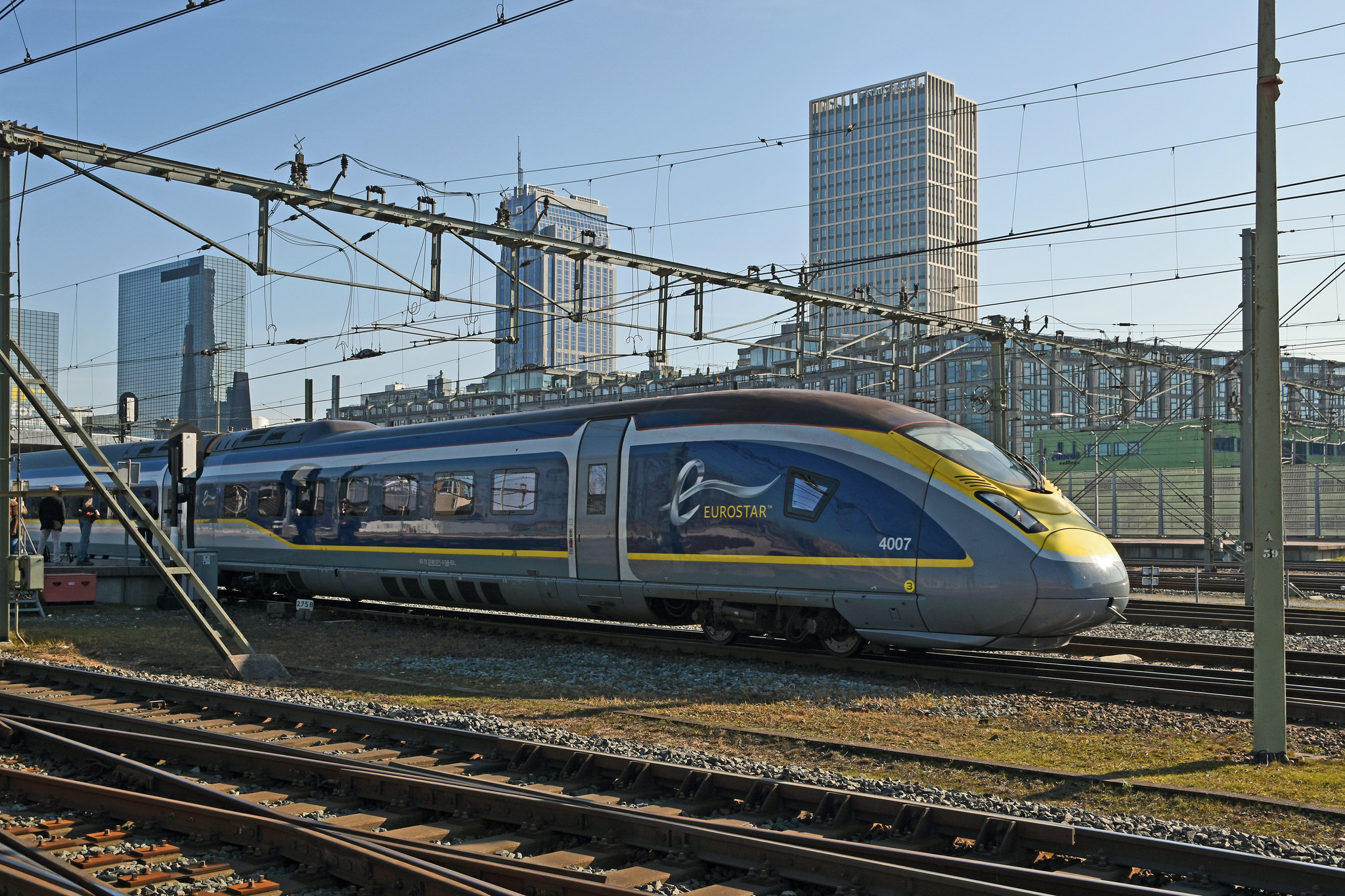
The second generation of Eurostar trains – 16 carriages, distributed traction, 390m length and with 902 seats. Eurostar owns 17 of them, all in service. The trains are built by Siemens, based on their Velaro platform that is also used for different variants of Deutsche Bahn’s ICE trains.
These trains have been fitted with ETCS and ATB to allow operation in Netherlands from the outset. Operation in Germany (or even Switzerland) under 15kV electrification would theoretically be possible, but approval has never been formally sought for either country.
There is not really any scope to run any more services with these trains, as they are the backbone of Eurostar’s fleet currently – the only opportunity for short term expansion would be to use these trains for new services (more trains to Netherlands, or theoretically trains to Germany) and deploy more e300 trains in Belgium and France. And there is definitely no scope to lease or sell any of them to anyone else.
Deutsche Bahn ICE3 Class 406
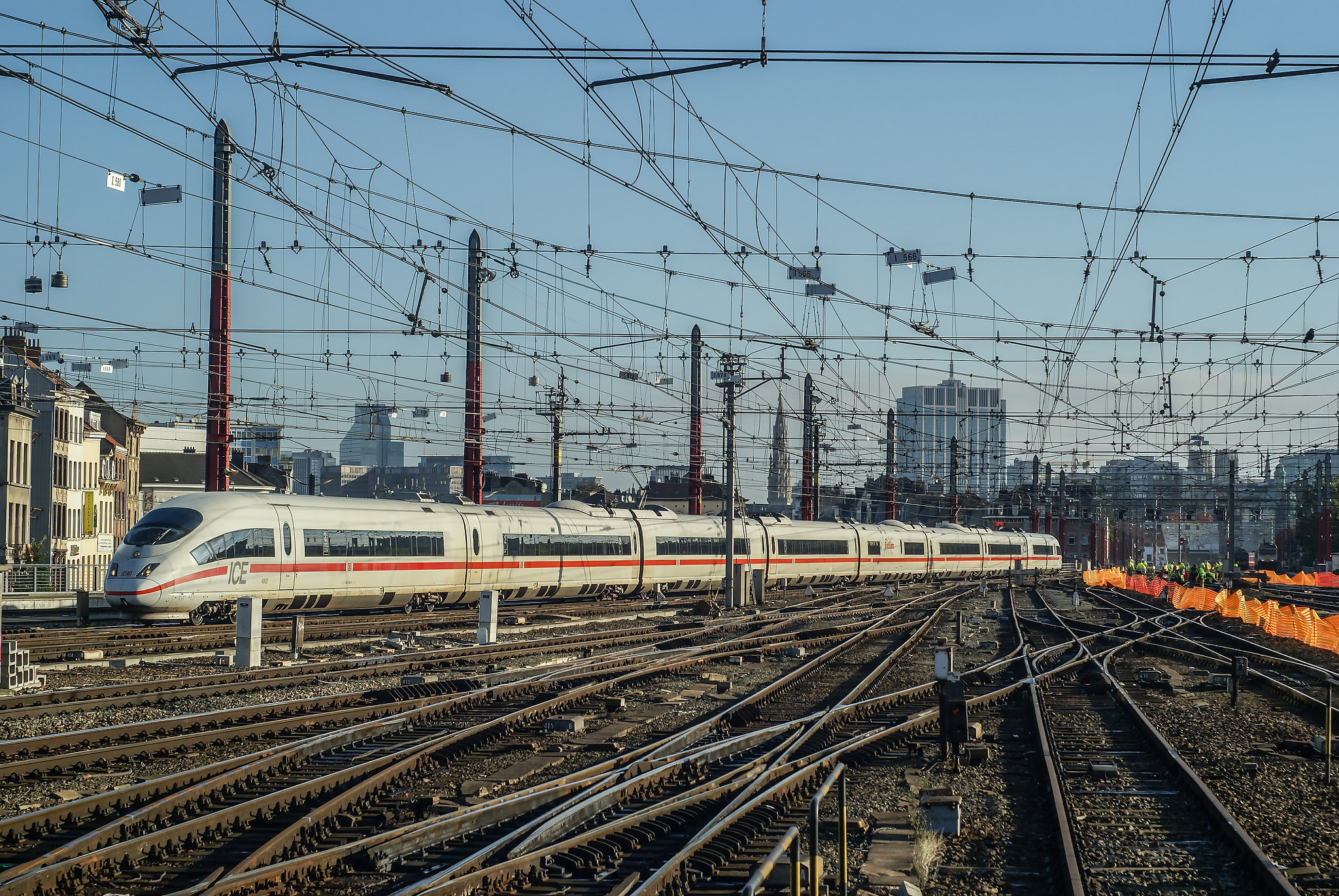
Class 406 is the train Deutsche Bahn was tested through the tunnel in 2013, but Deutsche Bahn has never run a regular service to London, and indeed these trains will never run to London in future either, so the technical details of these trains are not really of great concern here. This series – of which Deutsche Bahn owns 17 – currently operate Bruxelles-Frankfurt and Amsterdam-Frankfurt services, and have had a very questionable operational history. At least two of them have caught fire, and the reliability of the rest of the fleet is very poor, resulting in regular delays and cancellations on the routes on which they do operate. Rather than perform a standard mid-life maintenance on these trains, DB will instead remove the multi-voltage equipment from the trains, and in the future run these in Germany only. So for the sake of Channel Tunnel operations in future, ICE Class 406 can be ignored.
Possible future rolling stock
As there is little scope for increasing operations using existing rolling stock, what opportunities would their be for a new design of train to be used for long distance passenger services through the Channel Tunnel? Thankfully the answer to that is that there would be opportunities for something new, although not without some potential drawbacks.
Siemens Velaro
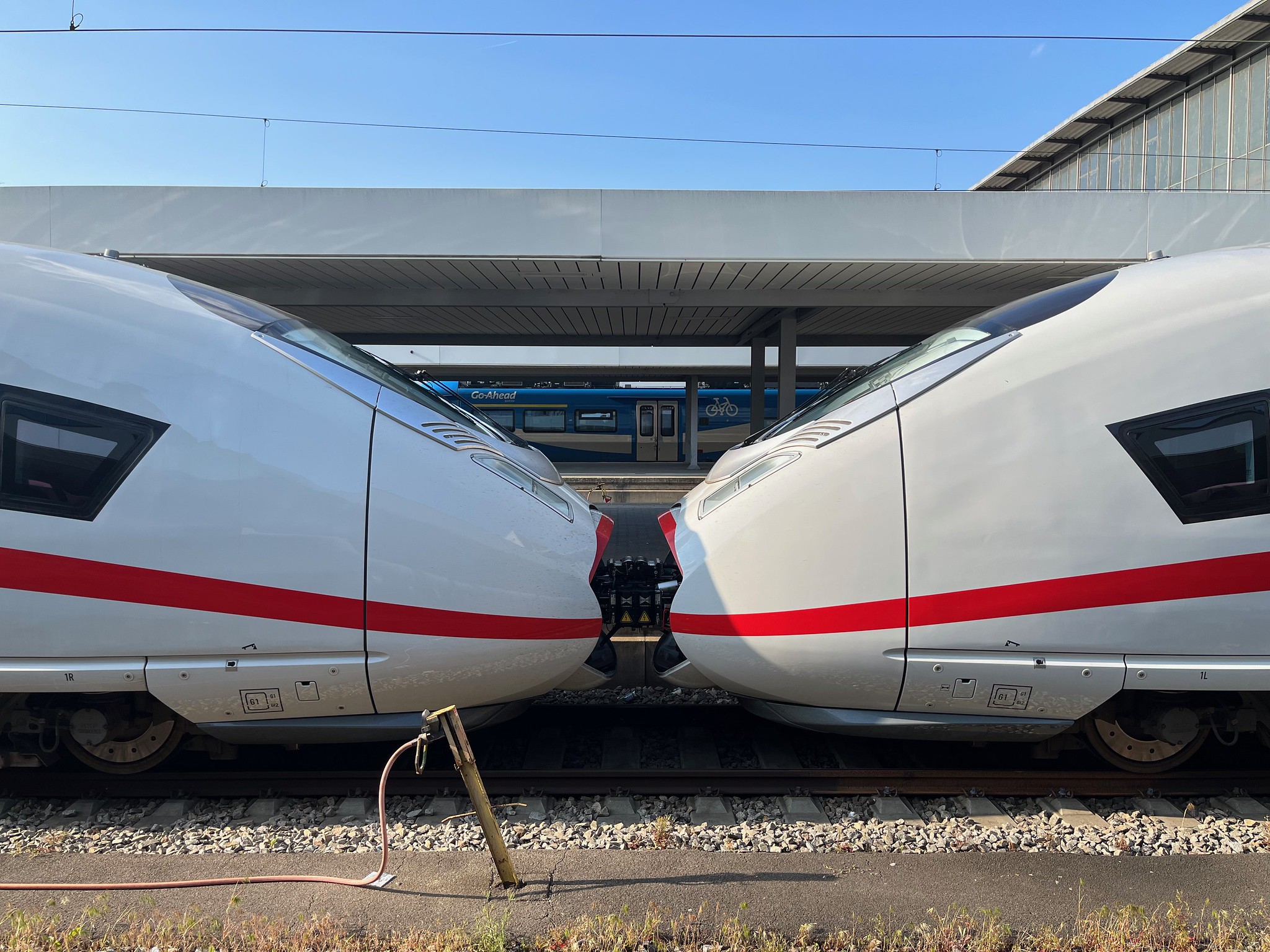
Siemens has continued to develop its Velaro platform, and is currently in the middle of the delivery of 90 ICE3neo Class 408 trains for Deutsche Bahn. These trains are 4 voltage (1.5kV dc, 3kV dc, 15kV 16.7Hz ac, 25kV 50Hz ac). Each train is 200m long, seats 439 passengers, and running 2 together to make a 16 carriage train is possible. Approval for Germany, Netherlands and Belgium is foreseen from the outset, with signalling and safety systems for these countries, but not including TVM430 and KVB (necessary for LGV Nord and High Speed 1). Whether DB would then be willing to have a France version of its 408s – with TVM – and a Belgium/Netherlands version without it is questionable. DB’s earlier Class 407 ICEs (also Velaro) do have TVM430 and KVB, but given DB only has 17 of those and they are currently in use on services between Paris and Germany, means deploying these to London would need something to replace them – and whatever that would be would need at least KVB to reach Paris Gare de l’Est. So – short to medium term – using either Class 407 or 408 ICEs to London is unlikely.
A new operator could of course place an order with Siemens for a Channel Tunnel compatible Velaro variant (with TVM430, KVB and ETCS from the outset), but given the Siemens plant in Krefeld has more than 60 more ICE408s to build, plus 41 8-carriage Velaro trains for Egypt, it would be likely at least 2028 and more likely 2030 before such a train would run.
Hitachi ETR 1000 and A-Train
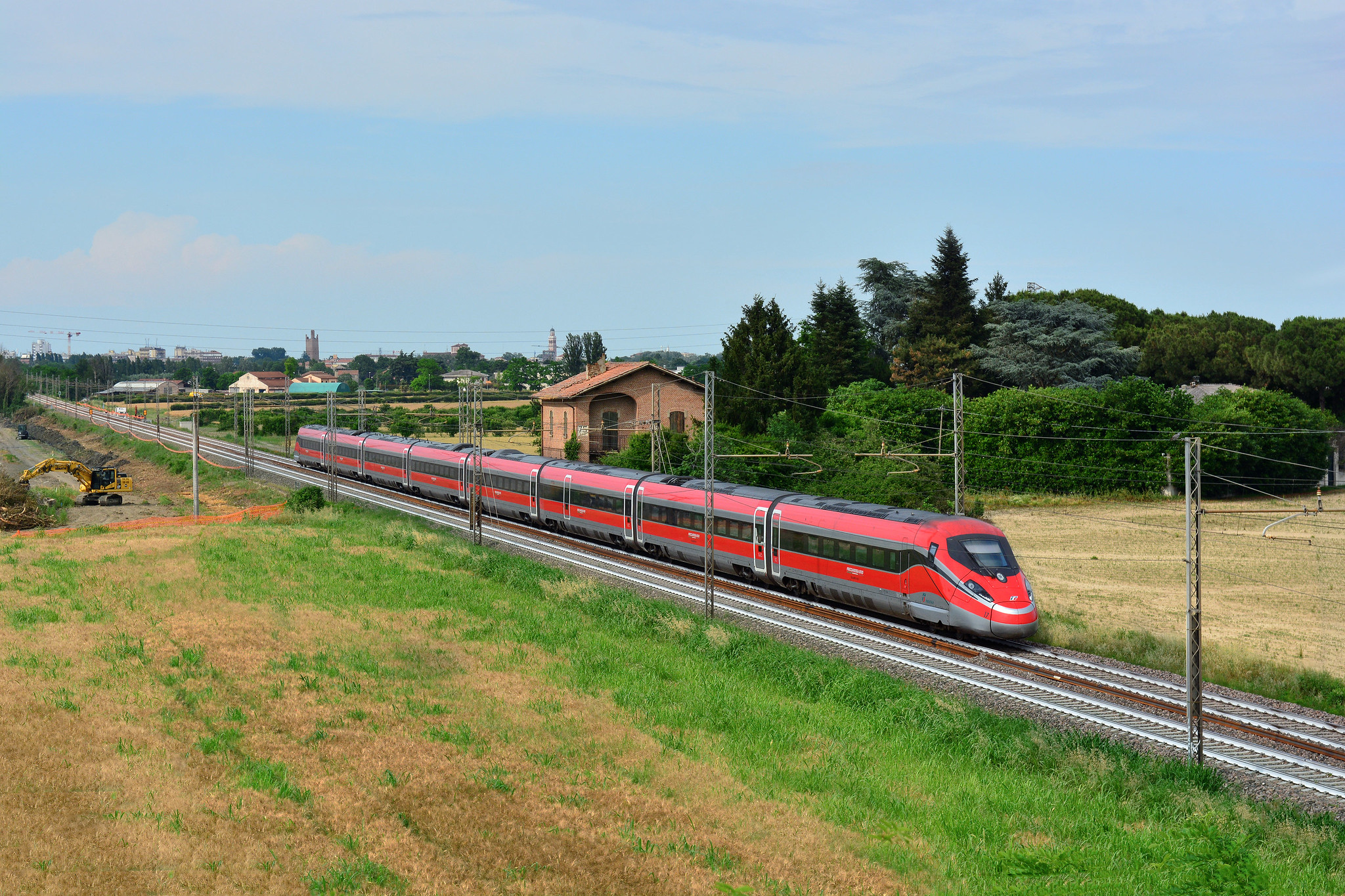
Also known as Frecciarossa 1000, ETR 400 or V300 Zefiro. Trenitalia already has a fleet of 64 of these trains, and in joint venture Iryo 23 more run in Spain. At least 30 and possibly as many as 40 more are on order, to be delivered from 2026. These trains are 4 voltage (1.5kV dc, 3kV dc, 15kV 16.7Hz ac, 25kV 50Hz ac). Each train is 202m long, seats 455 passengers, and running 2 together to make a 16 carriage train is possible.
Three sub-versions of the trains exist – for Italy, for France and Italy, and for Spain. The France and Italy version is the most interesting here, given it has TVM430 and KVB (and indeed even TVM300 to use LGV Sud Est), and all ETR 1000 variants have ETCS. This means that Trenitalia already has trains that fulfil the main requirements to run from Paris Nord to London St Pancras, although – I think – only 14 of them, and this fleet is also needed for Milano-Paris and Lyon-Paris services. Running to Bruxelles Midi with ETCS from 2026 would also be possible.
Given the outstanding orders for these trains for Trenitalia, they would be in prime position to be able to operate to London, starting earliest 2026/27. Were anyone else to order ETR 1000 trains, these would likely not be delivered until the end of this decade.
Hitachi also has another semi-suitable train in its portfolio – the A-Train series, on which the commuter EMUs for Southeastern that also use High Speed 1 are based. These trains are built to the UK loading gauge (which could potentially allow through services onto the West Coast Main Line, see Routes above) but none have ever been built for speeds above 225km/h as far as I can tell, ruling out using a train of this design on long sections of high speed line in France.
Talgo Avril
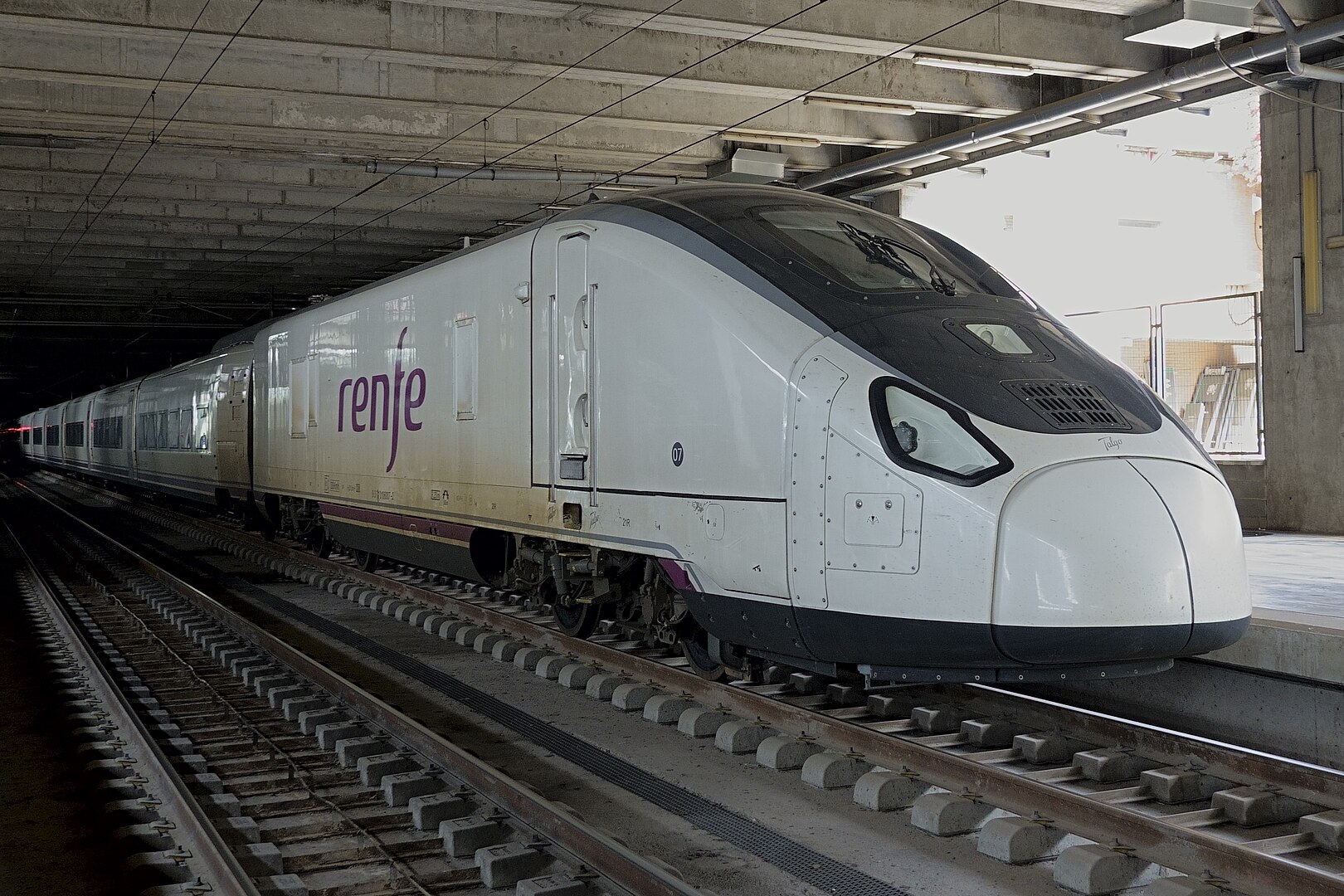
Known as Avril by the manufacturer, Spanish state owned operator Renfe ordered 30 of these trains – known as Renfe Series 106. These trains are 3 voltage (1.5kV dc, 3kV dc, 25kV 50Hz ac), and 10 of them will be equipped with signalling systems for France from the outset. Each train is 202m long, seats 521 passengers, and the design allows two of them to run coupled together. Renfe has had problems with approvals with TVM300 in the past, but not with TVM430 – so it is safe to assume these trains would be OK to run from Paris Nord to London from the outset. However at the time of writing, EU Agency for Railways has only approved these trains for operation in Spain and not in France (search Serie 106 here), and they have not entered regular service in Spain either. Plus Renfe seems to have plans to use these trains in France first of all, not through the tunnel.
Talgo is currently building trains for Deutsche Bahn and DSB, and also has a contract for 10 trains with Le Train – for a train of a very similar design to the Renfe 106, and to only operate in France, and due to be in service by the end of 2025. Assuming the approval headaches in France are ironed out, using a Talgo Avril / Renfe 106 derived design would likely be the swiftest way for a new operator to acquire rolling stock that could be used for the Channel Tunnel – probably in 2026 or 2027.
Alstom Avelia Horizon

The original Eurostar e300 trains were an Alstom-derived design, and while the company has not built anything for use through the Channel Tunnel in three decades, there is no reason why in principle it could not do so. The most obvious option would be a version of its forthcoming TGV M / Avelia Horizon design – essentially an updated 200m long, double decker design, that would seat around 600 passengers per train – more than anything else on the market with the same length. Loading gauge on LGV Nord and High Speed 1 is adequate for a double deck design.
However the problem is that SNCF has 115 TGV M trains on order from Alstom, and the first is only likely to run in 2025, meaning production lines are going to be full manufacturing these trains until the end of the decade. 15 of the ordered fleet are intended for international use by SNCF, with no indication that these would go to Eurostar (55% owned by SNCF), not least because SNCF needs a replacement for its ageing TGV Réseau fleet. Anyone else ordering Alstom trains – either Eurostar or a new operator – would likely be waiting until into the 2030s.
I suppose in theory a Avelia Stream / New Pendolino design could be adapted for the Channel Tunnel, but given its maximum speed of 250km/h and not 300km/h I do not consider this a serious option. As no one has ordered a Alstom AGV design for more than a decade, I think that option likewise merits no further consideration.
Other manufacturers
Stadler’s Giruno likewise tops out at 250km/h, and while it was designed for the Gotthard Base Tunnel (with its strict fire regulations), I cannot see any Channel Tunnel operators ordering them, nor SBB – the only current operator of this design – adapting any of its small-ish fleet of 36 trains to operate to London, not least as the 250km/h speed would pose path problems on long 300-320km/h high speed line sections through France.
CAF’s Oaris platform theoretically is capable of speeds of up to 320km/h, but so far only one small order has been made by Norway’s Flytoget – for speeds of up to 250km/h. Approvals for this design would have to start more or less from scratch, so would mean this is no short to medium term solution.
Importing high speed trains from China is likewise not given consideration here – approval of lower speed Chinese designs for Westbahn and Leo Express has not been successful, so I cannot see how this would work, short term, for high speed trains either.
Night trains
In the early 1990s the plan was to also run night trains through the Channel Tunnel – Nightstar. These carriages are mostly still in service – with Viarail in Canada. Returning these carriages to Europe (if Viarail would even sell), and rebuilding them back to European standards accordingly when the carriages are 30 years old would likely not be economically viable. A new night train design – perhaps based on the new Nightjets built by Siemens for ÖBB – would likewise pose problems, given the 230km/h maximum speed and the high axel load of the locomotives used to haul these trains. And any such services would face all the other passport and bag scan problems listed above. So night trains through the Channel Tunnel are not going to happen any time soon.
Operators
Eurostar
 The only existing long distance operator. Has pursued a retrenchment strategy since the COVID pandemic, with a focus on the biggest cities and its core routes, and upping its returns per passenger rather than reaching new customers. Stations such as Ebbsfleet and Calais-Fréthun will not be served in 2024, and short term its priority is the expansion of the service to Amsterdam, and possibly the re-introduction of some seasonal services (summertime to the south of France, wintertime to the Alps).
The only existing long distance operator. Has pursued a retrenchment strategy since the COVID pandemic, with a focus on the biggest cities and its core routes, and upping its returns per passenger rather than reaching new customers. Stations such as Ebbsfleet and Calais-Fréthun will not be served in 2024, and short term its priority is the expansion of the service to Amsterdam, and possibly the re-introduction of some seasonal services (summertime to the south of France, wintertime to the Alps).
Medium term its strategy is not as clear. Its merger with Thalys (now also branded Eurostar) gives it a foothold in Germany, but no rolling stock currently approved to run from there to UK. Most of the ex-Thalys fleet is approaching the end of its service life, as are its remaining e300 trains – so at some point the company is going to have to order something new. Eurostar claims it wants to double its passenger numbers by 2030, but has no discernible strategy to allow it to do so. However as the incumbent operator it still is the standard by which anyone else will be judged.
Getlink
 Getlink is the operator of the Channel Tunnel, and while it is unlikely to want to run long distance trains through the Channel Tunnel itself, in this March 2022 interview in Le Parisien, its CEO explains that the company is exploring ideas to purchase a fleet of trains and lease these to an operator – and Renfe is mentioned as a possible company to use those trains. However given Getlink has not made such an order by January 2024, and Renfe does itself likely have suitable rolling stock, at the moment there is a question mark as to whether this will happen. Getlink owns Europorte, a regular rail freight company, so has some experience in this sort of an approach.
Getlink is the operator of the Channel Tunnel, and while it is unlikely to want to run long distance trains through the Channel Tunnel itself, in this March 2022 interview in Le Parisien, its CEO explains that the company is exploring ideas to purchase a fleet of trains and lease these to an operator – and Renfe is mentioned as a possible company to use those trains. However given Getlink has not made such an order by January 2024, and Renfe does itself likely have suitable rolling stock, at the moment there is a question mark as to whether this will happen. Getlink owns Europorte, a regular rail freight company, so has some experience in this sort of an approach.
Renfe
 It has all gone quiet from Renfe since announcing in 2021 that they intended to run trains through the Channel Tunnel. However given that they ought to have 10 Series 106 trains available that ought to be able to be approved for Channel Tunnel operations reasonably easily, and that ordering more such trains from Talgo would be possible, they cannot be completely ignored, medium term.
It has all gone quiet from Renfe since announcing in 2021 that they intended to run trains through the Channel Tunnel. However given that they ought to have 10 Series 106 trains available that ought to be able to be approved for Channel Tunnel operations reasonably easily, and that ordering more such trains from Talgo would be possible, they cannot be completely ignored, medium term.
Trenitalia
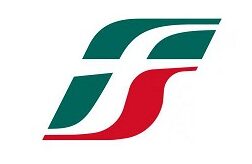 Italy’s state owned railway company has been pursuing an aggressive international expansion – rivalling SNCF between Milano and Paris, setting up the Iryo joint venture in Spain, and proposing to run international trains from Netherlands to France and Germany in 2027 through its subsidiary Qbuzz. However it has never had concrete plans to run to London, despite actually owning trains that could be used for that purpose. My assumption is that Trenitalia realises the operational headaches of running to London are all sufficiently difficult to mean focusing on other routes makes more sense. Never say never, but I cannot see Trenitalia stepping into this market this decade.
Italy’s state owned railway company has been pursuing an aggressive international expansion – rivalling SNCF between Milano and Paris, setting up the Iryo joint venture in Spain, and proposing to run international trains from Netherlands to France and Germany in 2027 through its subsidiary Qbuzz. However it has never had concrete plans to run to London, despite actually owning trains that could be used for that purpose. My assumption is that Trenitalia realises the operational headaches of running to London are all sufficiently difficult to mean focusing on other routes makes more sense. Never say never, but I cannot see Trenitalia stepping into this market this decade.
Deutsche Bahn
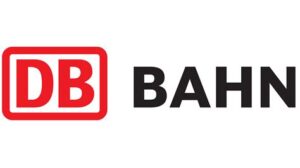 Deutsche Bahn, Germany’s state owned railway company stated recently that it had a “fundamental interest” in operating trains to London, but an interest and an actual plan are two very different things. Deutsche Bahn’s priorities, short term, are stabilising the services from Amsterdam and Bruxelles to Frankfurt, and offering extra services to Denmark and France (possibly including a direct Berlin-Paris ICE). Once that is all accomplished, and the availability of ICE trains for international services is clear, DB could then theoretically re-assess a London route – but I imagine were it to happen it is going to be closer to 2030 than to 2025. And even then the massive headaches with regard to station capacity in Germany might make them decide it is all too much hassle.
Deutsche Bahn, Germany’s state owned railway company stated recently that it had a “fundamental interest” in operating trains to London, but an interest and an actual plan are two very different things. Deutsche Bahn’s priorities, short term, are stabilising the services from Amsterdam and Bruxelles to Frankfurt, and offering extra services to Denmark and France (possibly including a direct Berlin-Paris ICE). Once that is all accomplished, and the availability of ICE trains for international services is clear, DB could then theoretically re-assess a London route – but I imagine were it to happen it is going to be closer to 2030 than to 2025. And even then the massive headaches with regard to station capacity in Germany might make them decide it is all too much hassle.
SBB
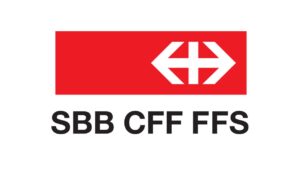 SBB-CFF-FFS, the Swiss state owned railway company, is currently concluding a feasibility study into the opportunity to run direct trains to London. However – as is typical of SBB – this is to be done in cooperation with other railway companies, likely SNCF and Eurostar (SBB already has a cooperation with SNCF – TGV Lyria – that could be adapted for this purpose). There is also political support for the idea. While Genève and Basel could be reached with Eurostar e320 trains, Zürich HB currently could not, and whether Eurostar would even have enough trains for such a joint venture is questionable. I cannot see this working short term, but towards 2030 this might just work out – given the operational ability, political support, and financial solidity of SBB.
SBB-CFF-FFS, the Swiss state owned railway company, is currently concluding a feasibility study into the opportunity to run direct trains to London. However – as is typical of SBB – this is to be done in cooperation with other railway companies, likely SNCF and Eurostar (SBB already has a cooperation with SNCF – TGV Lyria – that could be adapted for this purpose). There is also political support for the idea. While Genève and Basel could be reached with Eurostar e320 trains, Zürich HB currently could not, and whether Eurostar would even have enough trains for such a joint venture is questionable. I cannot see this working short term, but towards 2030 this might just work out – given the operational ability, political support, and financial solidity of SBB.
SNCF
 France’s state owned railway firm SNCF has a 55% stake in Eurostar, but it has a low cost brand – Ouigo – that it has used for international expansion in Spain. Development of a Ouigo-star market segment might make sense – a pack them in and sell tickets cheap alternative to Eurostar’s more premium offer. And the high capacity TGV-M trains on order from Alstom would suit this sort of service. However I cannot see SNCF undertaking something like this alone, but would instead pursue such an idea through the Eurostar Group.
France’s state owned railway firm SNCF has a 55% stake in Eurostar, but it has a low cost brand – Ouigo – that it has used for international expansion in Spain. Development of a Ouigo-star market segment might make sense – a pack them in and sell tickets cheap alternative to Eurostar’s more premium offer. And the high capacity TGV-M trains on order from Alstom would suit this sort of service. However I cannot see SNCF undertaking something like this alone, but would instead pursue such an idea through the Eurostar Group.
Heuro
 Dutch start-up Heuro announced in late 2023 that it intends to run up to 15 trains a day each way between Amsterdam and London, with stops at Schiphol Airport, Rotterdam Centraal and Antwerpen Centraal (peculiarly Bruxelles is not mentioned but surely would be served) and aims to start operations in 2028. The company has not said what trains it would intend to use, only that each train should seat at least 550 passengers. This plan is not without its problems – not least because such a regular service would require a large fleet of trains, and lots of paths (that might not be available). A fleet of trains running by 2028 would, at a push, be possible – but not from any manufacturer. And probably the biggest hurdle of all: the company wants to start from scratch. Sorry, but I have little hope this one is ever going to work, and I am definitely sceptical until a contract to purchase trains is signed.
Dutch start-up Heuro announced in late 2023 that it intends to run up to 15 trains a day each way between Amsterdam and London, with stops at Schiphol Airport, Rotterdam Centraal and Antwerpen Centraal (peculiarly Bruxelles is not mentioned but surely would be served) and aims to start operations in 2028. The company has not said what trains it would intend to use, only that each train should seat at least 550 passengers. This plan is not without its problems – not least because such a regular service would require a large fleet of trains, and lots of paths (that might not be available). A fleet of trains running by 2028 would, at a push, be possible – but not from any manufacturer. And probably the biggest hurdle of all: the company wants to start from scratch. Sorry, but I have little hope this one is ever going to work, and I am definitely sceptical until a contract to purchase trains is signed.
Evolyn
 I have written briefly about Evolyn before, and their plan is even bolder than Heuro’s – to run trains to London by the end of 2025. However their October 2023 annoucement they will purchase 12 trains from Alstom (possibly rising to 15 trains) was rebutted by none other than Alstom itself, stating that nothing had been signed. Exactly what routes Evolyn would run (indeed what countries they would even seek to serve) is unknown, although I presume France-UK would be the focus. Anyway running in 2025 with new Alstom trains is a completely hopeless proposition – as Alstom has some of the longest delivery times – for the reasons stated above. At the moment I see no reason to take Evolyn seriously at all, and I doubt they will ever run anything, but if they ever do sign a contract with Alstom or anyone else then I might revise my view.
I have written briefly about Evolyn before, and their plan is even bolder than Heuro’s – to run trains to London by the end of 2025. However their October 2023 annoucement they will purchase 12 trains from Alstom (possibly rising to 15 trains) was rebutted by none other than Alstom itself, stating that nothing had been signed. Exactly what routes Evolyn would run (indeed what countries they would even seek to serve) is unknown, although I presume France-UK would be the focus. Anyway running in 2025 with new Alstom trains is a completely hopeless proposition – as Alstom has some of the longest delivery times – for the reasons stated above. At the moment I see no reason to take Evolyn seriously at all, and I doubt they will ever run anything, but if they ever do sign a contract with Alstom or anyone else then I might revise my view.
Virgin Trains
 This one is really hard to assess, as we basically have only a newspaper story to go on. Richard Branson and his Virgin Trains brand are well known in the UK, although it is more than 4 years since they last operated. Other than Branson calling on former Virgin Trains boss Phil Whittingham to run the operation, and some speculation that Ebbsfleet and Ashford could be served, we know no more. Indeed it would even be theoretically possible that the Virgin brand could be used as a front for operations by Evolyn or Heuro or someone else. Until more concrete details emerge it is impossible to assess this one.
This one is really hard to assess, as we basically have only a newspaper story to go on. Richard Branson and his Virgin Trains brand are well known in the UK, although it is more than 4 years since they last operated. Other than Branson calling on former Virgin Trains boss Phil Whittingham to run the operation, and some speculation that Ebbsfleet and Ashford could be served, we know no more. Indeed it would even be theoretically possible that the Virgin brand could be used as a front for operations by Evolyn or Heuro or someone else. Until more concrete details emerge it is impossible to assess this one.
Flixtrain
Flix has shown no interest in running to London, and abandoned plans to run from Bruxelles to Paris. Its 200km/h locomotive hauled trains would be complex on High Speed 1, mixed with faster services, and I am not sure their trains would get permission to operate through the Channel Tunnel. At present: no chance.
SNCB
SNCB is 18% owner of Eurostar Group. Has shown little to no interest in international expansion over the past decade. Anything they will do they will pursue through the Eurostar Group.
NS
While NS owns no stake in Eurostar Group, the Dutch state owned railway firm has shown little or no interest in international expansion in recent years, and there is no indication they have any interest.
Conclusions
It’s complicated.
Whatever the hype about expanding services through the Channel Tunnel – either Eurostar expanding its offer, or new rival operators stepping in – the series of hurdles to overcome is enormous.
Foremost among them is the problem of terminal capacity at St Pancras, caused mostly by post-Brexit passport control requirements and the confines of the small terminal, and it being next to impossible to run to anywhere in UK other than St Pancras.
Expansion of services the other way – further into mainland Europe – encounters similar problems, where equipping stations for passport controls and luggage scans is either difficult or impossible, especially in France outside of existing Eurostar routes, and in Germany where the hurdles look insurmountable.
Set all of this against the backdrop of the UK’s pernicious and anti-European politics and a political solution for those problems looks hard in the short and even medium term.
Were all of that to be overcome, a new operator (or indeed Eurostar as well, were it to expand) is going to need new trains. Envisaging which companies could supply such trains is not too complicated, but the timeframe for their delivery means new services would likely only start years after operators would like to be the case.
No problem listed in this blog post is insurmountable alone, but the problems in combination mean I fear that many of these hopes for long distance services through the Channel Tunnel will remain unfulfilled.
Updates
This is Version 1.7.0 of the blog post, correct as of 22.01.2024, 13:20
Changes since Version 1.6.1 of the blog post, correct as of 18.01.2024, 13:45
– This comment alerted me to ETCS upgrades to Eurostar’s e300 fleet, and so the section on e300 trains has been updated accordingly
– Eurostar e300 trains no longer have 750v dc equipment – thanks to this comment. So they too cannot access the depot at Ashford, updated accordingly
– Line added about Charles de Gaulle Airport, in response to this comment
– Line added about Taktfahrplan in Switzerland in light of this comment
– Line added about whether DB would want an atypical sub version of its ICE 408 fleet, in light of this comment
– This discussion on Mastodon cast doubt over the minimum length requirement, with @Gusiluz pointing to some sources that indicate the 400m requirement was still in place – I have tried to integrate these points as well as I can in the article, but we still do not have a definitive answer
– The train length argument on Mastodon inadvertently pointed me towards Getlinks plans to acquire trains to lease to operators – in this piece in Le Parisien. A section about Getlink as an operator has been added
– More detail added about Renfe 106 series
– Link to details of the Brussels terminal capacity added – thanks Maartje!
Changes since Version 1.6.0 of the blog post, correct as of 18.01.2024, 13:45
– Barking OpenRailwayMap link was incorrect (this notified me) – now fixed!
Changes since Version 1.5.0 of the blog post, correct as of 18.01.2024, 13:30
– Line added about using Den Haag HS as a terminus station, thanks to this on Bluesky
Changes since Version 1.4.0 of the blog post, correct as of 18.01.2024, 10:45
– Paragraph added about temporary deployment of e300 trains on ex-Thalys routes – thanks to a former student of mine alerting me to this!
Changes since Version 1.3.0 of the blog post, correct as of 18.01.2024, 10:15
– Line added about alternative stations in Köln, in light of this post on Mastodon.
– Line added about longer term plans to move international traffic in Amsterdam from Centraal to Zuid
– Error with platform numbering at Zürich HB corrected – thanks to this
Changes since Version 1.2.0 of the blog post, correct as of 18.01.2024, 09:45
– Line added about Basel-Mulhouse getting a railway link and a new station, and perhaps that being an option for a stop for trains from the Channel Tunnel
Changes since Version 1.1.0, 17.01.2024, 16:45
– Section added about night trains (thanks to a comment on LinkedIn)
– Paragraph added about the Hitachi A-Train design (thanks to a point on Mastodon)
– Part about platforms at Stratford International amended, answering this comment and following this discussion on Bluesky.
Changes since Version 1.0.0, 17.01.2024, 15:45
– I was unaware that ETCS had been completed on the Swiss standard gauge network, so Integra-Signum is no longer needed there. Part of the blog post about signalling amended accordingly. Thanks @Pablo in the comments!
Credits
Thanks to Patrick Dersjant, Graeme Hilton, Martin Hoffmann, Tim Panton, Quixoticgeek, Jorge Martínez López and Skye for posing me the questions to make this piece better. And special thanks to the members of the best Telegram group about railways – you’ve helped a lot with this piece, you know who you are! However all errors in this piece are mine and mine alone.
Creative Commons Images used in this post
 Ant Miller
Ant Miller
Waterloo
October 24, 2007
CC BY-NC 2.0
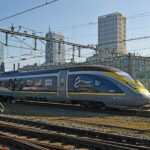 Huib Smit
Huib Smit
Eurostar E320 4007/4008
February 23, 2019
CC BY 2.0
 Michael Day
Michael Day
London: St Pancras International
May 8, 2019
CC BY 2.0
 Albert Koch
Albert Koch
ICE Brussel 406 502-5
September 29, 2012
CC BY-ND 2.0
 FDV
FDV
Renfe Class 106 train at Córdoba railway station
March 27, 2022
CC BY-SA 4.0
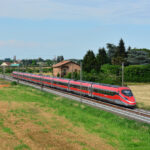 Nelso Silva
Nelso Silva
FS ETR 400.17
June 13, 2023
CC BY-SA 2.0
 Roger Marks
Roger Marks
Ebbsfleet International
April 17, 2010
CC BY-NC-ND 2.0
 Franklin Hunting
Franklin Hunting
Gare Du Nord
June 16, 2008
CC BY-ND 2.0
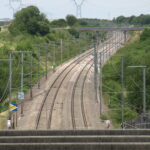 Morten Jensen
Morten Jensen
LGV-Nord
July 21, 2015
CC BY 2.0
 Martin Deutsch
Martin Deutsch
Passport Control
November 8, 2007
CC BY-NC-ND 2.0
 shirokazan
shirokazan
Channel Tunnel Terminal
August 6, 2011
CC BY 2.0
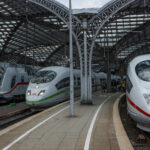 Albert Koch
Albert Koch
Colourful Cologne
September 6, 2020
CC BY-ND 2.0
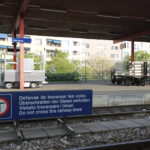 Jared Kelly
Jared Kelly
Geneve – Gare Cornavin
May 1, 2009
CC BY-NC-ND 2.0
 Allain Lloyd
Allain Lloyd
TGV M N°997 en essais sur la ligne Paris Montparnasse Brest entre Plouaret Trégor et Plounérin
July 6, 2023
CC BY-SA 4.0
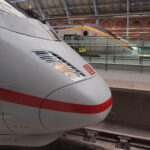 Julian Walker
Julian Walker
German ICE Train at St Pancras
October 19, 2010
CC BY-NC-ND 2.0

Great blog post! Thanks for condensing this information. I could also see SBB making an effort to run connections to London. I also believe their other international connections are increasingly popular.
Im not sure about the requirement for Integra-Signum in Switzerland. SBB claims the following in their website:
“Thanks to the network-wide use of ETCS Level 1 and Level 2, the entire Swiss standard-gauge network can now be operated without the use of an additional national train protection system.”
Source: https://company.sbb.ch/en/the-company/responsibility-society-environment/customers/sbb-and-safety/train-safety-etcs.html
Im not very knowledgeable about these things, so I might be missing something.
Ah I wasn’t aware that had been completed. Will update the blog post accordingly!
Excellent post Jon!
There is currently an E300 being fitted in Belgium with ETCS as I type, with the rest of the E300 fleet to follow, at a cost of £1million per power car! The latest potential retirement date I heard for these sets is now 2036!!! ????
Do you have a source to confirm that please?
I’m a Eurostar driver.
Ah I like the answer 🙂
Thanks for the explainer. Given all these issues, is it possible to turn Lille into (more of) a Eurostar transit hub, allowing reasonably convenient connections to Geneva, Strasbourg, Lyon etc (avoiding the time killer of changing stations in Paris)? Any big technical barriers to this, or just requiring commitment from SNCF, LYRIA etc on good Lille connections?
No, no real reason making that impossible, other that attitude. Lille Europe has only 4 platforms, so you’d need to be semi efficient with turn-arounds, but the depot is close and easily accessible – so holding trains there if you needed to would be an option.
I wouldn’t rule out Cologne. Platform 1 could be cordoned off as it serves a single track only. However, this track is generally in eastbound usage and any westbound traffic would either cross or block counterflow trains.
An alternative would be to leave eastbound and take a route via Deutz, Kalk freight yard and the Südbrücke. Trains departing east of Cologne would need to take this merry-go-round as well, as there is absolutely no capacity to reach platform 1 from the east.
Adding Düsseldorf alone doesn’t really make sense, as it’s only a few minutes away and it would currently require additional border control personnel to be present there as well.
You could cordon off platform 9 in Aachen, but it’s likely to be a too small market. Both Cologne and Liege are directly reachable by frequent trains. Aachen would currently be a completely different problem, as the train would have to stop at the platform to change the overhead current. I have my doubts whether this would please the current UK border control policy.
I’d rule out Frankfurt for capacity reasons, as there are already plans to add an additional sub-surface long-distance train station under the current one. That will take years of construction, which will likely affect the capacity of the current station.
Destinations south or east of Frankfurt seem to be a bit too far by means of travelling time from my point of view.
This basically leaves Cologne as the only meaningful German destination. But if you’re not from Cologne and would have to change trains there, you can do so as well in Brussels for quite some destinations, which is already an existing option and meanwhile Eurostar is already selling through tickets from the former Thalys stations to London.
Also: how long are the platforms in Aachen? Surely not 400m? This presents another problem there.
As for Frankfurt – I disagree with you there. The reason for the tunnel is for speed and Deutschlandtakt, and capacity towards the east / Fulda. A Channel Tunnel train would arrive from the west, so finding a platform for it should not be impossible I think!
Platforms 6-9 in Aachen, where the overhead current can be switched are between 401 and 421 metres long. That would be the least part of a problem. But even then, there is basically no space to install border and baggage checks, there is just one foot tunnel connecting the platforms and the platform 8/9 isn’t that wide. The terrain doesn’t allow extension to the south as well.
The crucial part is getting through Cologne anyway. When we think outside the box, it could be feasible to build a new platform at the currently unused freight part of Cologne West (track 12 on OpenRailwayMap). There are plenty of regular trains and a direct underground connection to the main station and services from Frankfurt or Düsseldorf could go there via the Südbrücke.
On Frankfurt, I meant that the upcoming construction works will take out track and probably platform capacity for quite a while. When the new tunnel is there, the situation will look different for sure.
In my eyes, the main limitation is not technical: If it is not possible to perform border checks on the moving train, any extension would require British border guards to be present at any departure city. This is unlikely a service which is available free of charge so you need frequent departures from that city so this pays off. Furthermore, the further you go, the less people are on that train, as you can’t fill up with domestic or intra-Schengen passengers on London bound trains.
Beyond all that: Any city with flights to London City Airport will likely reduce the number of possible business passengers. This is a factor for both Düsseldorf and Frankfurt.
In my opinion, the railway companies should probably focus on the sales side and offer through ticketing. Since the Thalys-Eurostar merger, I am now able to get a throught ticket from my hometown Dortmund to London. For any destination not served by Eurostar, I need separate tickets, which leave all delay and cancellation risks with me. While I can buy tickets in a single transaction, the fine print states that each one is a separate contract when it comes to passenger rights. While any business travellers will just pass the bill on, if they’re not sitting in the plane anyway, this is a major catch for leisure travellers, which you need to focus with the longer running services.
An interesting article I’ve have to redraft this reply several times as Eurostar and travel though the tunnel as a passenger is such a complicated issue with mostly political issues in the UK causing problems,
I travel via Eurostar a few times a year and I was encouraged that the last time I went through St Pancras in September a new passport booth had been installed and for my next trip in a few week fares (Harrogate in the UK to Geneva) of £39 single are available again after not seeing anything below £69 since Brexit in 2020. Hopefully allowing Eurostar to run there trains at capacity again and get to pre Brexit service levels again which will mean they can run a service based on filling a train with low priced seat rather than having to relay on expensive tickets.
However I think you’ve put too much focus on the technical aspects for a new operator which seem challenging but possible to overcome and not enough on the political situation in the UK.
It seems that rules and legislation put in place by the UK parliament are the main limitation to more cross channel train services and have stifled every attempted by anyone other than Eurostar to run trains to Europe, including limiting the use of UK bound trains as domestic trains in Europe which is why you can’t travel from Amsterdam to Brussels on London bound trains. Unfortunately as legislation needs to be changed to allow for any changes that could drastically change this situation there needs to be a political will to do this, which seems lacking in the UK at the moment for any sort of transport improvement (from the local road being full of potholes to HS2 being cancelled).
With regard to the Channel Tunnel (Security) Order 1994 the operator of trains through the tunnel is required to provide security of passengers and their luggage. From my understanding it is never particularly spelled out in the legislation that this should be airline style security but it was assumed by MPs (partially of the governing party in 1994) that this would mean airline style security.
Lets hope that with a change of Government and the younger generation in the UK being more pro europe it will not be long until the political issues can be resolved.
Given I spent years analysing Brexit (see these diagrams!) maybe I went too far the other way here and concentrated on the technical aspects more.
As for the Channel Tunnel (Security) Order 1994 – there is some scope for differences of luggage checks I think. Checking every bag does not mean making every passenger take off their watch or their belt.
But sorry, I have no hope whatsoever that any of the political limitations here are going to change any time soon.
A fantastic, detailed post, adding a healthy dose of reality to the frenzy over new operators and destinations. Thank you.
I’d love to learn more on the prospects for Stratford. It seems so well-connected, and ripe for a bespoke terminal fit for the post-Brexit world.
What is the issue with reversing trains there? I had thought a new operator could use platforms 2&3, shifting Southeastern to the unused platforms 1&4, and allowing crossover to the East of the station? Or am I wrong.
I know the question of staffing & Border Force/ PAF is often raised, too. Would it be outlandish to think a consortium of interested parties (Getlink, HS1, local authority) might build and manage everything that’s needed?
I will answer this as an update to the main post, as it has also been posed as a question on social media! But in short: switching the platform arrangement looks to me to not be possible.
I just read, Jon, your update about reversing trains in Stratford not being possible due to the 400m length of Eurostar trains, because platforms 2 and 3 (the only ones where that would be possible) are only 250m long.
But what if shorter 200m trains are allowed to operate in the tunnel?
The different infrastructure managers (Getlink, etc.) could demand cheaper fees for low-cost, Ouigo-like services using Stratford as terminal instead of St Pancras.
Another, related topic: what about using Paris Charles de Gaulle as terminal, in case of future constraints in Paris Gare du Nord? Paris CDG is better connected to regional transport than Marne-la-Vallée – Chessy, I believe.
Paris CDG could also be interesting as through-station in the area of Paris for operators such as Trenitalia or Renfe, who might prefer to continue the trip towards the South instead of spending time entering Paris Gare du Nord.
200m trains would work at Platforms 2/3 at Stratford, yes. But would it be worth switching Southeastern services to 1 and 4 for that? Perhaps, but I’m not sure.
CDG: there’s no platform to cordon off I think. But I’ll check and add to a further update.
Interesting to note that on the other side of the Schengen area border control could be done within Allegro trains between Helsinki and Vainikkala or St Petersburg and Vyborg (or within those intermediary stations if boarding from there), although I seem to remember that luggage was not scanned. Something to learn from?
Also at the Romania-Hungary border at Curtici (EU, but only Hungary in Schengen) these controls were also done on the train. Border guards had special portable passport scanning machines. It’s eminently do-able – the question is if the Brits want to do it!
And not to forget that before Switzerland joined Schengen/Dublin, they did a complete border check (border police, customs, drug sniffing) on the IC(E)s between Freiburg and Basel Bad Bf, within 25 minutes.
Jon, an excellent summary of all the constraints – so what could realistically be achieved in the near term? I would advocate for an Ebbsfleet-Ashford-[Calais]-Lille shuttle – with Ouigo style no frills approach perhaps initially using refurbished older E* units which might otherwise be scrapped for what is after all quite a short journey. Then look at the possible connectivity improvements. Ebbsfleet has huge car parks and is not far from the M25 – rename it London Parkway perhaps. A walkway/travelator to adjacent Northfleet station would give better access to the North Kent line and thus Southeast London and also the Elizabeth line at Abbey Wood. Ashford could be given a direct service to Reading – perhaps in combination with an improved Reading-Gatwick service splitting at Redhill as well as an upgraded service to Brighton and further along the South coast. Lille already has a good range of services which might be enhanced, eg Strasbourg trains extended to Basel and/or Stuttgart Some services from Germany to Brussels could be extended to Lille, perhaps even sleeper services using Lille Flandres. As to a lack of stabling at Ebbsfleet – just run the last service through to St. Pancras and have the first very early service depart there before standard E* services. Maybe a couple of these no-frills services could be extended beyond Lille to Marne for Disneyland, and also to Bourg-StM for winter ski services. How many train units would be required for a reasonable start-up service and what might a timetable look like?
I imagine something like that would be possible with between 5 and 8 e300 trains, and it’s a solid idea. But would Eurostar be willing to do it? Or if not could anyone else get their hands on the e300 trains to do it? I fear the answer to both of those is a no.
Thanks for the reply. An additional note on connectivity. At one stage it was contemplated there might be an Overground service to/from Old Oak Common along the West London Line -maybe it still it. Such a service could potentially run through to Northfleet adjacent to Ebbsfleet where there seems to be room to add another platform for terminating trains. Northfleet also already has Thameslink trains to Luton. Travellers are quite used to going to airports out of town, so why not Ebbsfleet if it has good connections. Those who want to go direct to/from the city centre, can pay the premium for St. Pancras services. I am sending a link to your chef d’oeuvre to Ashford Borough Council in case they haven’t already seen it.
I know we are trying to not incorporate financial considerations in this discussion, but the Tunnel’s unusual pricing system for track access – per passenger and not per train path – bears mentioning here, especially when considering high-volume, low fare operations such as the shuttle model described in this comment thread, or the Ouigo-like service described in the main text.
Track access costs are a main issue, of course. Applies also to France’s SNCF, which has a higher track access prive for any international passengers services to my knowledge. The reduced rates for non-Paris inland routes do not appply for international routes, I think. Much worse are Channel Tunnel prices and charges along HS1 (it possibly had been owned by the same infrastructure fund that still invests in Eurostar).
Railway infrastructure owners have to take into account that fees for a longer route should not be higher or even add up those of sections, but must be lower, because the airfare is about the same, but rail operating costs are higher, so less can be spent on track access charges. Similar for night trains which can carry less passengers in a given number of coaches in sleeper compartments.
Stuttgart has a nice “lost place” station at Ebitzweg, which could be augmented / supplemeted with 400 m isolated and enclosed platforms rather easily, connecting to the tram or with a 1 km walk to Bad Cannstadt. No need to use Stuttgart 21. Connects to Munich. Some sprinter ICE without stop at Stuttgart used to pass through there 1995 – 2006. Relevant investment for few trains, though.
The concept could be to split trains close to Strasbourg between Zurich and Munich (or even in three, to add Frankfurt). Can train sections be designed in a way that they can be split, but when combined walk-throgh is possible in line with Channel Tunnel requirements?
First and foremost, this is an excellent analysis of the situation (permission to refer to it whenever discussions come up?). Thanks for this work.
It is going to be a whole laundry list of comments… in chronological order:
Intermediate stops in the UK: I am not familiar with the regulations, but servicing may not be such an issue, if the trains were actually running Paris – Stratford/Ebbsfleet/Ashford (quick turnaround) – Paris. Main servicing point would be Paris.
Route to Switzerland: Genève and Basel would not require 15 kV electrification. Basel Centralbahnhof is actually to stations, Basel SBB, and Basel SNCF (with 4 tracks following SNCF standards).
Track capacity/scheduling to Basel. The obvious way for serving Basel would be via LGV Est and Strasbourg. In an ideal world, the London trains would be used as TER200 between Strasbourg and Basel, running in the according Takt. As stated, beyond Basel (towards Zürich), it might get tricky, but the ICEs from Germany are part of the IC Basel – Zürich – Chur Takt (so feasible, but ideal world requirement).
I may misunderstand it, but one aspect concerning stabling has not been mentioned. I believe to remember having read that the stabling tracks must be fully isolated, which means, in no way accessible without control. This would be way more a killer argument than the isolation of the platforms (and as far as I have seen, Ouigo does isolate platforms too…).
I have to get political… as stated, the killer at the moment are the brits and Brexit. Of course, at the moment there is no hope that the brits would even consider joining Schengen/Dublin, even if it would simplify things considerably (and, no, you don’t need to be a member of the EU to join, see Switzerland). The baggage screening, OTOH, could be trashed any time; there is no justification to do this theatre at all anymore! I think getting rid of these hindrances (and the isolation requirements) would be the primal conditions to expand services to London.
More about Basel: A bit of a kludge, but there are serious plans to build a loop to the EuroAirport (which is actually to airports, MLH (France) and BSL (Switzerland)). There would be a chance to build a 400 m long isolated platform, and mindset and staff would be available. A quick transfer to the Basel RER would connect to the world…
Stations in Germany: München is an utter Murks. Half of the tracks at Hbf are in Flügelbahnhöfen, and they are not even capable to get all intercity-level trains into the main hall. So, forget about isolated platforms…
Station capacity in Switzerland: It is correct that the “SNCF” section and the “SBB” section can be separated; this is occasionally done, when they decide to do a thorough customs check on an incoming TGV (and they love to filz the Swiss for meat, and the French for cash). 400 m platform length could be achieved (but decisions have to be done quickly, as the reconstruction programme is about to start.
Rolling stock: Question is how much grandfather rights a Velaro may have for the Channel Tunnel certification. But then, it still would need HS1, and France. But that still would not significantly shorten the procurement time. In order to do that, one would have to come with a really big order, which would justify Siemens to expand production capacity.
From traction technical point of view, enabling a 25 kV/50 Hz vehicle to operate under 15 kV/16.7 Hz is relatively simple; there may/will be a need to find space for another one or two pantographs, and some component modifications, and the rest would be software issues. Concerning signalling, yes, conversion to ETCS would make things so much easier…
Musing about a bi-level train is moot, IMHO, because serving the 910 mm platform height in the UK would reduce the train’s capacity significantly… and that would also affect Talgo.
The conclusion says it all. The biggest obstacle for more London services is political.
Yes please do refer to it when discussions crop up! That’s what this post is FOR!
Re. stabling – I was not aware of that requirement for the stabling locations to also be secure, but Temple Mills, Forst and Lille are, and I presume Landy must be as well. Eurostar never left the platform when it went to Bourg Saint Maurice, but how did they do it in Lyon I wonder? And that requirement could well be a headache for stabling in Germany, and I don’t know how it works in Amsterdam either.
Re. all the Swiss points – I agree with all of those.
Re. a stop at Basel Airport – that’s a good point, and I will add a line on that!
Thanks…
About the stabling: in Marseille, it was not needed, because they did turn around the train in roughly 45 minutes, at the platform. De-training in Lille allowed to work with non-cordoned-off platforms in Marseille and Avignon. Stabling in Lyon… there is a Téchnicentre TGV just south of Part-Dieu, or (if serving Perrache) the Vaise yard could provide space. Otherwise, short turnaround.
Another thought about the Channel Tunnel capacity. By slowing down the Eurostars to the speed of the Shuttles, it would be possible to squeeze out one additional path, available for other trains.
Basel to be rebuilt concerns Basel SNCF track layout etc., whereas the station building (aka West Wing) is finished, and there are only small customs facilities left; anything border control, and the “french” waiting hall are now “shopping and feeding”.
One issue you will also have in Switzerland is that you will only get a path from Basel to Zurich if you integrate your service in the domestic network. Basel – Zurich is very busy (and there is no difference in number of trains between peak and off-peak), and you will only get to run in an IC path if domestic passengers can use the train too.
You see that with TGV Lyria which actually just runs as a domestic IC between Zurich and Basel.
Long distance international trains only are viable if they serve multiple markets. And that includes domestic markets. That there is a train several times a day from Interlaken to Berlin is not because so many people want to travel that route. In fact, most of the people boarding the ICE to Berlin in Interlaken are only going as far as Bern.
Similarly the 2 hourly service from Zurich to Vienna exists not because of the end to end demand, but because of all the places it serves.
Hence longer services to/from London are only viable if they serve multiple stops. That could be possible if a) the security theatre gets abolished and b) passport control is concentrated in London. In such a scenario you could probably even run a London – Lille – Strasbourg – Basel – Zurich every two hours, and have good loadings.
Late response, today I found time to read an article about “EAP by rail”.
While there is space for separate platforms at the planned station location (when encroaching on the parking lot), planned rail connections to rest of Switzerland are mediocre at best, and then you have the competition next door (an airpoirt that could offer direct planes to London without any futher investment).
… as long as the world consists of Basel. Having an additional change to go anywhere else doesn’t look very promising. At least there is ample parking.
One aspect you have not covered is the difficulty in incorporating the TVM signaling solution with ERTMS systems, as explained in this document:
https://www.autorite-transports.fr/wp-content/uploads/2022/07/executive-summary_onboard-safety-systems_vf.pdf
Hitachi (who own TVM) are more interested is selling their bi-standard ERTMS/TVM signaling solution rather than developing a TVM STM that can be used with other manufacturers ERTMS EVC systems:
https://railway-news.com/hitachi-rail-to-provide-onboard-digital-signalling-for-sncfs-tgv-m-fleet/
Interesting, thanks. But that’s then going to be a much wider headache than just in this case, surely?
It is a problem for anyone trying to crack the French high speed market (of which the Channel Tunnel is only part). A major advantage for DB with the Class 408 is that it can be used for the international services to Belgium and the Netherlands as well as domestic German routes, therefore you only need to have a single pool of trains for both (which results in considerable cost savings). If DB wanted to run Class 408s to London (or anywhere in France for that matter) then they would need a separate pool of trains specifically for France, like they had with the ICE3MF (Class 406) and they have with the Velaro D (Class 407).
I read something recently of how the ICE3M trains were modified to become ICE3MF. They had to make a lot of modifications to the trains in order to be able to install the TVM equipment (and in the process lost the authorisation for Belgium). When the ICE3MF trains were replaced by Velaro Ds they ripped out all of the modifications and turned them back into ICE3Ms so that they could be used for the Brussels and Amsterdam services. Getting authorisation for the ICE3MFs took about 6 years of testing and over 100k km of test runs. It is much easier to get a French TGV authorised for Germany than get a German ICE authorised for France.
I think that any plans to run services to London should be part of a wider strategy to crack the French High Speed market.
Great article. 🙂
When picking new continental stations, one should know the objective. Frankfurt (Main) Hbf. is located quite centrally in Germany and has direct connections to almost all large cities; similarly (but less so ) for Cologne (Köln) Hbf.
A Channel-Tunnel-Train-Stop there would allow two-seat rides from many parts of Germany to London. With a lowly station in the boonies like Frankfurt (Main) Südbf. (occasionally floated in German discussions) or “somewhere in Cologne”, you have to take a metro/suburban train from the Hbf. to this station, giving you a three-seat ride. What would be the advantage compared to a three-seat ride with a change in Brussels, as is possible now? Certainly not the better facilities (eating, nearby hotels) at the station.
Then there are the economies of scale, as el_emka already pointed out: not only regarding the number of stations, but also number of countries. Operating juxtaposed border controls needs an agreement between both governments, and that’s probably easier if fewer countries are involved. That would favour Basel/Mulhouse Euroairport, as you might piggyback on the existing Franco-British agreement; connections with other routes would be better Basel SBB station. Spreading your stations over multiple countries would increase the needed lobbying effort.
You are aware I live in Germany, right? I am in Köln or Frankfurt more often than I am in London!
Good to know 😀
I just had a look at Köln with some aerial picture website and I’m wondering wo zum Teufel “would be space at Köln West or Köln Ehrenfeld to build a complete new terminal”? Did you mean ‘somewhere within a few kilometres of the stations’ or somewhere deep underground?
But a terminal in Frankfurt Hbf (for Germany-wide connectivity) and a stop somewhere in Köln (to serve the area) sounds quite good.
Why not Köln Gremberg?
As someone else pointed out it kind of makes sense to consider if the trains can be used for local transport and since they can’t I think it’s hard to see much point in building new terminals for chunnel services. Without the ability to sell tickets that are only good on side of the channel you’re kind of limited to only selling each seat once per trip, making longer journeys less economical.
An additional problem with the longer journeys is that even if you decide to do those you might still need to call at a few stations, necessitating building more terminals. For travellers who need to change trains anyways having a terminal in Cologne might not be much better than the one in Brussels. I guess you could get somewhat faster trips if journeys out of Cologne would skip intermediate stations but you still need to fit everything into an attractive schedule where a trip every hour or two via Brussels might still beat the twice daily ex-Cologne.
One joker in this would be if more secondary stations ends up getting built and used. Frankfurt has the airport and south stations, Cologne has Messe, Munich has East, etc, and if there are other long distance high speed trains using those stations it might be more natural to also use them for cross channel trains if they’re better suited than HBF. That would require a lot of growth though so I would sort of just expect someone just adding more services from the existing terminals, taking advantage of the fact that lots of new trains are made to be flexible in terms of fitting them to operate on new lines.
That said the biggest problem here is that it’s a hard sell to start making investments in overcoming hurdles that are not technical. Even if it might be good business to create a new terminal you still face the risk it becomes obsolete if ever political agreement is found to make either immigration or bag scan smoother. This kind of create a dilemma where you can only get more terminals if you announce you’ll never ease restrictions which is obviously suboptimal.
That could be solved by treating all passengers as international (full Schengen exit controls on boarding at any station, even intra-Schengen, full Schengen entry controls on alighting at any station).
Thanks for all the comments! Keep them coming!
I have now (Monday 22 January) incorporated responses to as many of them as possible into the text of the post.
Maybe it is worth mentioning the recent press release from Getlink:
https://press.getlinkgroup.com/news/getlink-to-enable-the-doubling-of-direct-high-speed-rail-services-from-the-uk-over-the-next-10-years-via-the-channel-tunnel-8ee5-0791e.html
Most of what was in that press release is just fluff, and reads like a CEO trying to appease the shareholders, but there was one thing that caught my eye:
“Integration of tunnel specific criteria with manufacturers in their standard rolling stock offering”
It is becoming more common for train manufacturers to be responsible for homologation rather than the customer, and it gives manufacturers such as Alstom the opportunity to have their standard rolling stock offering pre-approved for channel tunnel operations.
As you rightly point out, most of the Eurostar ex-Thalys fleet is approaching the end of its service life and they will need to start ordering replacements in the next few years. They will also need to expand their fleet if they want to run additional services to Germany. If a manufacturer like Alstom were to include the “tunnel specific criteria” in the trains that Eurostar ordered from them, then Eurostar would have a fleet of trains that meet the requirements for running services to Germany, but could also be used to run services to London (if the opportunity ever arose).
If Eurostar were running a service such as Brussels-Frankfurt (as a “Red Eurostar” service), and a decision was made to add passport control facilities to Frankfurt to allow direct trains to run to London, then they could introduce such a service relatively easily using the same rolling stock that they would be using for their Brussels-Frankfurt service. The service start up costs for them would be very low compared with other possible service providers (such as DB), and the service could be introduced in a similar way to the London-Amsterdam service.
Yeah I read that last week. And it’s so vague I don’t know what to possibly make of it!
The “tunnel specific criteria” that Getlink refer to in their press release relates to safety systems. Most trains will be built to meet the standards specified in the LOC&PAS TSI, but trains that use the Channel Tunnel must meet the stricter Channel Tunnel safety standards.
For example, the LOC&PAS TSI standards require that fire barriers provide a minimum of 15 minutes of protection, but the Channel Tunnel safety standards require at least 30 minutes of protection – The preferred fire evacuation procedure is to continue to drive through the tunnel to an emergency siding at the exit and evacuate the train there, and the 30 minutes protection is required to enable the train to exit the tunnel in the event of a fire. The Channel Tunnel safety standards also specify where fire barriers must be installed, including barriers to protect the driver and fire protection for pipes, hoses, wiring, and equipment for 30 minutes.
The Frecciarossa trains that Trenitalia have on order _may_ be able to meet the Channel Tunnel safety requirements. On the 31st of December 2023, a new Italian safety regulation for existing tunnels and rolling stock entered into force. It may be that these stricter requirements will result in the new stock meeting Channel Tunnel safety requirements, but as far as I can tell they are simply applying the LOC&PAS TSI safety standards to existing rolling stock (i.e. removing their grandfather rights).
Does Stratford have the capacity (in theory) to manage an entire train’s worth of passengers? The lack of reversing facilities could be overcome by running empty between Stratford and St Pancras.
You could leave half the train at Ebbsfleet by running 2×200m trains coupled instead of one 400m train; then you could also reverse the shorter train at Stratford.
I believe the idea was that trains go to St. Pancras, but relieve customs /security checks by taking up some passengers at other stations.
a few ideas for Lyon –
Perrache – most of the platforms have pre-boarding areas now, perhaps one pair of platforms could be given over to London services?
Part-Dieu – definitely not an ideal place for border checks but what if they built another platform face for Voie A? or they could even consider Brotteaux and a walking connection.
Bellegarde has an unused platform alongside the old station building, but this faces towards Culoz and not Nantua.
At London, perhaps the old Night Ferry platforms/Orient Express area at Victoria could be re-used for some slower conventional-type service? although, if you’re building new stock it may as well be high-speed
The more I think about it, the more I suspect Virgin to be involved in Evolyn or Heuro. Perhaps more conceivably Evolyn.
Lyon Part-Dieu and elsewhere:
To add one additional cul-de-sac platform near a station just outside of the main building may be feasable here or there. Loocking at Lyon Part-Dieu at google maps, the westernmost rail (at a dual platform) could get a small dead-end extension south of Rue Paul Bert with an isolated single-side platform. The platform in the station would only have to be bypassed when London trains arrive and depart. The bigger issue would be the rather low daily use that may not warrant an extra investment of this kind. In any case, bypassing Paris with its requirement to take a Metro between stations would be a huge benefit for passengers from southern areas.
One drawback of Lyon is that many trains from Southern France bypass without stop.
Do they manage to make security checks at Lyon for trains to Spain?
Good work, thanks!!
But MLV has 3 tracks serving 2 platforms, and ALL of those allow for through operation.
The original idea behind was to allow charter services to serve and turn around at MLV. It also proves useful to absorb delays and other incidents (especially when heading towards LGV PSE), as more trains can cross / pass each other.
That track layout is also helpful when operating Ski services London SP / Amsterdam C Bourg St-Maurice and ZonThalys Amsterdam C – Marseille SC, as those make a quick technical stop in MLV so as to swap drivers and re-stock catering supplies.
How did they do it with Eurostar to Disneyland? Did they somehow fence off one platform or not? (I admit I have never got out there – Disney isn’t really my thing!)
Yes, the platform is fenced off. Same kind of fence as in Lille-Europe. Connecting doors remain open, so long as no cross-Channel service is not there.
If so, Track 3 (West) is sterilised and TGV services use Tracks 2 (Middle) and 1 (East).
I used to connect on a regular basis in MLV between TGV serving Lorraine TGV and others serving the Southeast, so I know the place 😉
Some more comments:
– Rang du Fliers – Amiens is still devoid with wires.
From Calais to Amiens and St-Omer, speeds remain restricted to 140 km/h, even though curvature allows 160, and even 200 on some short sections (French doctrine requires 20 km at least to raise speed from 160 to 200 vs 10 km in Germany)
– When the Channel Tunnel Rail Link Act 1996 was passed at the House of Commons, capacity allocation on London SP – Ebbsfleet provided for:
– 8 tph each way in Cross-Channel traffic
– 8 tph each way (peak hours)in London – Kent traffic (4 tph off peak + 1-2 Freighters)
= up to 16 tph, consistent with top speed capped to 225 km/h – 140 mph.
– Any substantial offer increase in Ashford will require some investments with a view to segregating Arrivals from Departure flows
+ platform widening by removing the “Down Fast” (through track) (The remaining “Fast Up” track should be enough to accommodate all freighters in both directions)
– On the way to Bordeaux SJ, one should call at St-Pierre des Corps (for Tours), the busiest railway hub in Western France. Currently fitted with only 4 tracks and 2 island platforms, but there is room for more on the South end.
– If operated as a pass-through-only station, Lyon Part-Dieu may have capacity for a Channel terminal, using newly-built Track L (platform is wide enough to be divided by fence)
– The former Channel terminal in Avignon Centre is still in place…
– Calling at Liège-Guillemins will require substantial fencing around Track 1
– The Brussels-bound underground platform in Antwerpen C is wide enough to be divided so that Track 24 can be used by London-bound services
– As the National Mobility Plan 2035 is being implemented in Luxembourg, there won’t be enough capacity for a Channel terminal in Luxembourg-ville (new RE to Differdange and Belval via the Pétange by-pass will even require conversion of Track 0 (next to Track 1) to passenger use and demolition of adjacent administrative building).
Great post Jon. You write that Eurostar’s ‘short term priority is the expansion of the service to Amsterdam’. Would you know / have a source stating when to expect how many extra trips? Also, can you estimate if Eurostar’s upward boundaries for expansion in the Netherlands are in terminal or track capacity or rather in rolling stock or attitude? I’m especially interested in creating public debate about conditions for using the above mentioned the Hague HS platform 1 (plus its iconic royal waiting rooms) as a short-term London rail destination. Latest projection for Amsterdam Zuid Eurostar opening is 2032-2036 al least. Furthermore, as concluded in the Europa Spoort Niet meet-up, any official public debate about the reasons behind unused rail potential on heavy short flight routes is good to have now.
Long-distance daytime services (e.g. Munich – London) are inattractive if no intra-Shengen passengers can be carried on partial intervals (e.g. Munich-Stuttgart, Stuttgart-Paris CDG, Paris CGD-London).
Different for sleeper trains, which by definition have some point-to-point characteristic rather than “stops all along”. Departures would also be at a time of day when stations are not that crowded any more, so easier to reserve a platform for an hour or so.
So look once again at Zurich and Munich, but also consider Barcelona, Madrid and beyond (with existing security provisions in Spain), Berlin (might serve less crowded Gesundbrunnen, but also space available at Berlin Hbf. underground), Nice (with some lauding gauge issues beyond Marseille, however), Kopenhagen (when Fehmarn tunnel has opened), even Vienna may be suitable
Can departing platforms be “cleared” rather short before departure?
What is the situation on the return leg, can passengers depart trains from “unsecured” platforms and at additioinal stations?
For daytime routes, a stop at Antwerp would increase comfort, irrespective of closeness to Brussels.
Dusseldorf is closer to Cologne than Antwerp is to Brussels. Most passengers boarding there would come from other parts of the Greater Ruhr area (10 mio. inhabitants in Rhein-Ruhr-area, thereof 5 mio. in Ruhr area excluding Dusseldorf and Cologne) anyway, rather than Cologne proper (1 mio. inhabitants). Dusseldorf has all the connections to other medium and major German cities (Hamburg, Bremen, Hannover, Berlin in addition to Ruhr area) that Brussels does not have. Cologne-West: 1 platform only! “Small town” Aachen would not be served, but by ICE to Brussels.
For Frankfurt to London, travel time through Brussels or along Strasbourg – Paris probably could be quite similar. For the southern alternative, Mannheim (5 large dual platforms) and (to a lesser extent) Karlsruhe are also places to look at, including for connections from Stuttgart. Do not worry about no stop at Paris, as the train would bypass anyway. If CDG was available, at least there would be conrol staff nearby. For Paris CDG, it would be a “selling point” if train security control would be accepted for transit to the airport, and vice-versa, but I doubt that would happen.
Big issue is the notorious unpunctuality of Deutsche Bahn, so acceptable provisions for passengers that miss a connection to London would be quite important.
France also has some of these TGV stations “in the middle of nowhere” like Macon-Loché TGV (on the Geneve – London route), Valence TGV (on Marseille – London route) and (less nowhere) Lyon St. Exupery,with parking and car rental as main infrastructure aside rails. Locking off the northbound platform of such raher desolate place for an hour now and then would seem feasible. Not so much as a terminus, but to add more passngers from a not too distant endpoint like Geneve, or Marseille, If feeder connections can be organized. St. Exupery has a (rather expensive, though) tram to the centre and occasional stops from Marseille, Montpellier of OuiGo-TGVs.
Finally, there used to be London-bound trains from Bourg St. Maurice in the Alps.
That would be propositions to run 2 or 3 trains per day and direction, not every hour or every other hour like to Paris or Brussels. A business case with just 200 m trains would certainly help,
I missed Milan with a large terminus in the night train propositions. Yes, it takes time to build a rolling stock for night trains, and most state railways are not interested. But possibly add ÖBB, European Sleeper and RegioJet to the list of operators in question.
Manufacturers:
If some have a large order backlock from a state-owned incumbent,, this does not mean that all of their manufacturing capacities are used up. The purchaser may just have preferred to stretch deliveries – and later service intervals – over a couple of years.
For contrary: If an order of some 100 trains is out, the manufacturer may be more willing to add a smaller order (with some reasonable modifications) for a London service, while would not be keen to build a dozen of trains standalone.
Did you rule out trains form Birmingham too soon? Adopting single-deck train designs for a different track gauge should not be that difficult, see adoptions for wider gauges in Northern or Eastern Europe.
Then, 400 m trains from the Continent could split at Stratford International, one half going to Birmingham (or elsewhere) and the other remains in London. If that half ends in Stratford International, the train would use the middle platform and the section to Birmingham would be in front, already beyond the platform, with no option to leave. If continues to St. Pancras, that part would be in front and not allow departure at Stratford, while the the Birmingham sections allows departure at Stratfort – so to give some flexibility in case 2/3 of passengers come from London on some day, and extra comfort for those having better connectioins at Stratford.
If no space in Birmingham, then Manchester Picadilly seems to have a near-idle rail at the northern end, and travelling to Europe may warrant the extra walk.
Thanks also to the good and intensive observations!
To offer connections to London from more stations, the easier or quicker option seems to be feeder trains (e.g. from Marseille, from Geneve, from Zurich, from Munich, from Dusseldorf/Cologne/Berlin), change trains at a station with existing control (e.g.Lille), continue to London in a shuttle train. The drawback is control capacity at that change station. Therfore, it appears to be better to have feeders for only half of the capacity of the train to London.
Rather than rush to control 800 passengers at Lille, the feeder to Lille would carry only 400 passengers and these shall combine at Lille with passengers in another train with another 400 passengers to be controlled at Brussels (or at Paris).
That could mean:
a) A half-empty train from Brussels (35 min. from Lille), other half of places to be boarded by the remaining passengers in Lille, or
b) (better) A “half” train section is waiting at the “controlled” platform in Lille, that can be entered by passengers immediately upon each of them having passed UK controls. It is combined with the other half-train from Brussels upon arrival of that. The feeder could also be a train from Germany that passes Brussels without UK control, for its passengers to join those of a train from Brussels or Amsterdam at Lille; but a feeder from the south that passes by Paris makes more sense.
Drawback: This generally needs two shorter trains to Lille and thus two times track access charges for the route to Lille, or put differently, halves the potential capacity of the feeder trains (assuming there is not so much traffic going exactly to “small town” Lille, which could come on top of the London passengers in the feeders).Also the second trains that are combined with the feeder has only around half of the capacity.
This should support a claim to SNCF réseau to charge only half of the usual track access charges (of non-Paris trains !) for such specific circumstances, where the effective capacity is reduced due to constaints in UK-related control.
On the return leg, trains sections can split in the same way or alternatively two would run together. The latter case could mean trains every two hours from Basel to London, but only every four hours from London to Basel (or Zurich, Bern). Change of trains at Lille may still be required on the return leg, otherwise the feeders to Lille would have to be searched through for continuation to London (impossible? How it that done with Eurostars remaining overnight at Amsterdam or Brussels?).
Version c) A feeder from Brussels that drops passengers for London at Lille, picks up passengers from London and continues to parts of France south of Paris (and vice-versa). Thereby, some through passengers would also fill that train, and the delay from the stop at Lille is acceptably short. This would lead to many interdependences in timetables and be more prone to delays, so less feasible. Also,passengers to Lodon probably are more numerous than those on such through trains, and the leg from Lille to the south is probably more significant that the north-western one.
d) A similar option could be set up with feeder-designated trains from the south stopping at Lille Europe and continueing to Brussels, but without expectation to pick up Londoners there (i.e. also rather empty on the Lille – Brussels section).
Version e) Departing at Eurodisney / Marne La Valee seems infeasible, since it was less efficient to set up another high-capacity control station only for the through passengers there. Better design for higher thoroughput at an existing station.
Version f) Full length trains (e.g. from Basel) split at Marne La Valee or CDG-airport, one half continues as feeder to Lille, the other half goes to Paris Gare du Nord or Gare de l’Est. At Lille, combination with more passengers on train from Brussels. Once again, a lot of coordination requirement only to save on track access charges.
None of this is very convenient, in particular in case of night trains, for passengers with significant baggage or for children travelling alone.
Off topic: A lot of “Eurostars Hotels” exist in Spain, with branches also in Munich and Berlin. So it would be nice to serve these places with an Eurostar or feeder train.
I think the underlying assumption – that nobody is going to start building new facilities, like bespoke platforms and stabling and the like – is a good one, but how would matters change were the government (for environmental reasons) announce a plan to heavily-tax, or even ban, short-haul flights to areas that are within reasonable railway travel time? Could that provide the impetus to build bespoke infrastructure at stations on the continent, or turnbacks at Stratford, or hypothetical routes from Heathrow? My crayons are at the ready.
Some aggregated comments, having come to this only recently via London Reconnections –
Re: Security and Border checks
* The early days of Eurostar, prior to Schengen being enacted (1/5/1999) and the events of 11/9/2001, conducted fewer security checks AND on-train passport checks between Lille and Calais; IIRC trains were able to make an unscheduled stop at Calais Frethun if required to remove undocumented passengers. Certainly I remember UK border agents on the train and follow-up checks at Waterloo. On the outbound leg passport checks were definitely done on arrival at Brussels Midi; any checks at Waterloo were for entry to France and not Belgium. Exit checks at this time were not a thing for any of the 3 countries.
Additionally, although names may been printed on tickets, there was no cross-referencing and anyone with a valid passport could travel using any valid Eurostar ticket.
* After some discussion elsewhere (I think it was Twitter) among people (including me) remembering NO security checks boarding Eurostar prior to Sept 2001, and others remembering airport security even then, it was identified that this was a “selective checks” process – a fixed subset of passengers being selected at random for the security path but others being waved through. The proportion was apparently varied according to security threat level, and subsequent to September 2001 was increased to 100% and remained there.
* Prior to Schengen, and various countries joining Schengen, on-board passport checks, and in some cases customs checks, on trains were very common. Pretty sure they’re still a daily occurrence crossing in or out of Bosnia, Serbia, N Macedonia, Montenegro, Bulgaria, Romania, Ukraine and of course Belarus and Russia. However they are typically conducted on a train stopped at a border station rather than on the move. Indeed; I have heard stories of undocumented travellers being booted from trains at border stations and being held by authorities until forced departure on the next train back the other way. Or even being left at some remote border station to fend for themselves in the dead of night.
* For a long time, Brussels-Lille was considered an immigration loophole where it was possible to buy two tickets – one to Lille and another to London – and avoid passport control at Brussels before boarding the train. Various measures were enacted in order to combat this, including checking people out of the station at Lille to ensure everyone who was supposed to disembark had done so. Nevertheless this was not enough and carriage of passengers from Brussels to Lille on London-bound trains was eventually stopped.
FWIW I think the biggest barrier to on-train checks is the security control rather than immigration BUT it would help the immigration picture significantly if the UK were able to immediately return undocumented arrivals at St Pancras (as Russia/Belarus in particular are known to do at border stations) rather than being obliged to entertain on-the-spot asylum claims. I’m really no supporter of UK leaving the ECHR, but this element of asylum policy has a real impact in this context.
Re: Stratford, Ebbsfleet and Ashford
Presumably it would be possible to address the outbound passenger capacity issues at St Pancras simply by limiting the seat allocation there and filling the train at one or more of the other locations. The challenge is the limited demand for travel other than to/from St Pancras, and the additional fixed costs to any operator of operating from another currently mothballed location – think not only security/border control and customer service, but retail, cleaning, maintenance and back of house staff management/welfare. None of it insurmountable but the economics here would add to ongoing operational costs – infrastructure investment might be more expensive on paper but probably easier to justify and come from government or private finance rather than add to the day to day expenses of any operator.
Re: Lille hub (and the “detrain” option)
I think it’s important to recognise that “the problem” is for services TO London rather than FROM London. Services from London can happily trundle along to anywhere the infrastructure supports without being concerned about passports or security checks. Eurostar’s London-Amsterdam service has for two periods operated on a one-way basis and having used it in both modes myself, I preferred changing in Brussels for the return leg as it was actually quicker – the long check in and poor facilities at Amsterdam added time and waiting around. Although the new facilities in Amsterdam should be an improvement, we can only assume that provision at future outlying destinations will be similarly limited and not provide a great passenger experience. But the through outbound leg is still a great selling point for UK travellers even if they have to change on the way back.
So I would suggest that services could operate direct from London to various destinations, with the stock operating return services terminating at Lille and passengers passing through the relevant controls before boarding a connecting train to London. The empty stock at Lille could then be cleaned and screened in the depot before forming a later service to London. Or could even form a service from Lille to Paris or Brussels before returning to London.
Re: Birmingham or other UK destinations beyond HS1
There has recently been talk of reviving the link from HS1 to HS2 in some form. It is a great pity that no provision was made in HS1 for an onward continental gauge connection; the only viable options seem to be widening the North London line through Camden or tunneling all the way to Dagenham. Neither is very appealing. Nevertheless, HS2 to Birmingham Curzon street seems to me the strongest contender of the poor options there are, simply because it would be fast and, with a suitable connection, operable with continental gauge stock.
Great article – also came via London Reconnections re-post. Three comments:
On difficulty of reversing in platforms 1/4 at Stratford – if the St Pancras constraint is throughput, not platform capacity, then could these trains potentially continue empty to St Pancras and reverse there?
On potential destinations – it might be worth overlaying these on where passengers are actually travelling, by air (the Civil Aviation Authority has this data publicly available), and how that compares with potential journey times and likely share of passengers who would shift to rail. That would narrow down the list of realistic destinations where any investment in e.g. platform segregation, passport control might be justified. I suspect Amsterdam is by far and away the largest and underserved route before any others (e.g. Dusseldorf, Frankfurt) are considered, and that many are tiny and would never justify a regular 900-seat (or even 400-seat) service at a sufficient frequency to compete with air.
On night trains – perhaps challenging now, but they’d operate at times when St Pancras and the tunnel have more capacity, and in time, as the cost of flying increases (environmental charges etc), I can’t see a world where using this capacity would not become so desirable as to overcome challenges of rolling stock and passport controls.
Re: Security and Border checks: I have been a regular Eurostar passenger since 1994. In regard to the Security aspect, Paul is correct with his observations above. Indeed I would like to add to that. Prior to 2001, even when picked for a check, the security people were only looking for one thing: Semtex plastic explosive. Everything else was minor. On the issue of Immigration checks, these were also carried out on the train between Brussels and the Channel Tunnel. I still do not know why to this day, these cannot be undertaken on the train (as in the past) as the Officers would be given more time for their checks.
Through trains to Germany. For those of us who live and work in Germany, the current timetable from London to Germany is not optimal. Currently the timetable gives either a change duration of 25min (too short) or nearly 90min (too long). A direct service is required (there is no air service anymore between City and Düsseldorf). Portable scanning equipment (as used at Disney) could be installed at Düsseldorf, Deutz and Aachen. Passport checks could be carried out on the train.
What about Leeds? I guess access to the ECML via would still be via the North London line, but over a shorter length so less disruptive? As it is it takes a little over two hours to get to London with 4-5 stops, so it might take about 2 hours direct (and I’ve heard it suggested that when the line’s been resignalled there’ll be potential to run trains at up to 140mph, as on the Northern end of the line into St Pancras); NLL to Stratford is less than 20 minutes if we assume that a through service can go no faster than the local services, and then it’s a little over two hours on to Paris – so the overall journey time is basically acceptable in terms of what people are willing to do by train. Leeds itself is a decent sized town, and the direct connectivity up the ECML and over the Pennines is good and set to get better.
It feels like it ticks all the right boxes politically – Birmingham might be the second biggest city in the UK, but it still feels a long way South to much of the country! – whereas Leeds would feel like a railhead for continental services in The North as such.
Regarding rolling stock, do we not have a drop-in solution in the ‘classic-compatible’ units being built for services along & beyond HS2?
Examining stations in the UK, and how to serve them, is someone else’s job – sorry! While I may have a UK passport, I aim to mostly stay out of UK rail arguments.
This is excellent and I cannot thank you enough for putting this out there, it’s incredibly helpful. It adds so much more to my knowledge of these issues and helps me explain other people why I believe that services to other destinations seem unlikely.
I think that in light of the most recent news about yet another imaginary plan to extend services elsewhere, it is still worthy to update with a little tiny note the part about passenger capacity at St. Pancras. I’m sure you’ve seen the BBC article, there it says:
“London St Pancras Highspeed, which owns the station and operates the track to the Channel Tunnel in Folkestone, has already set out proposals to increase capacity for international train travel from 1,800 passengers per hour to almost 5,000.”
Now, I know that from a proposal to an actual plan that becomes action there is a big difference, but this shows that there is at least some intention to overcome this problem in the future.
I totally understand that this would only solve one of the many hurdles, and unlike what the headlines say it still doesn’t amount to any plan of services to Germany nor does it make such plan more likely to come to fruition.
But it is the first of the hurdles and it means that at least there would be scope for Eurostar to bring service levels back to what they used to be in the past, and maybe consider some of the seasonal routes again.
Thanks for the kind comment! Please note however: I haven’t updated this post in 12 months. I need to completely update it in light of recent developments.
There is no terminal platform at Marne-la-Vallée.
Each of the 3 tracks that serve the 2 island platforms are connected at both ends, and at the southern end there are stabling tracks where the Thalys and ES trains terminating here used to be stored. The westernmost track can be secured for Eurostar, while the other two remain accessible from the other platform.
A pretty efficient and flexible design, although the bypass tracks are barely used (all trains stop here bar a few Ouigos) and having only 3 (or 2 if a UK-bound train is being prepared) tracks for passenger service can be a bottleneck if several trains follow each other closely.
On a side note, it may be further from Paris than CDG but the RER ticket is cheaper at 2,50€ instead of 13 (although this is not relevant for the millions of locals who have a navigo pass).
Yeah I have been there since writing this post.